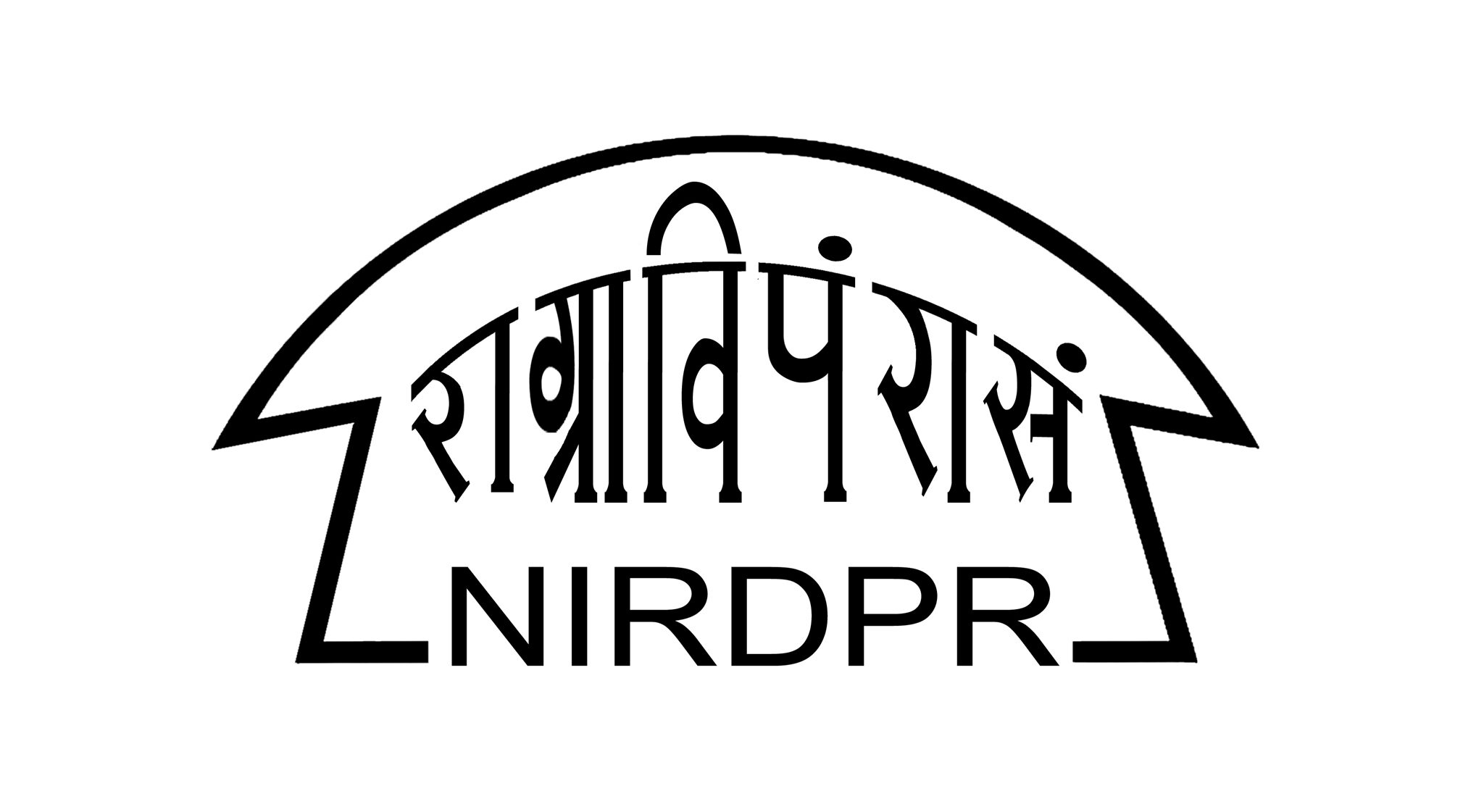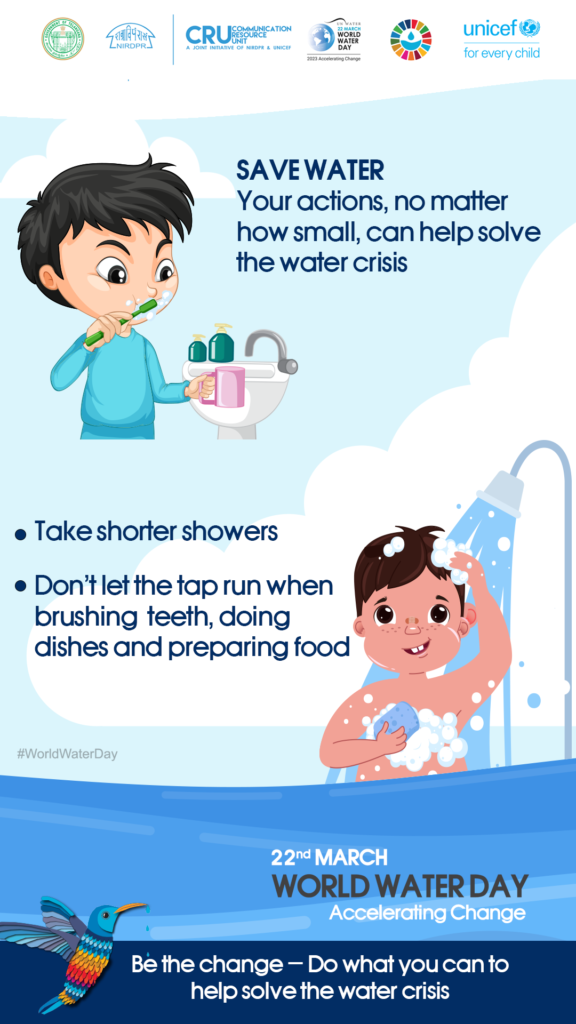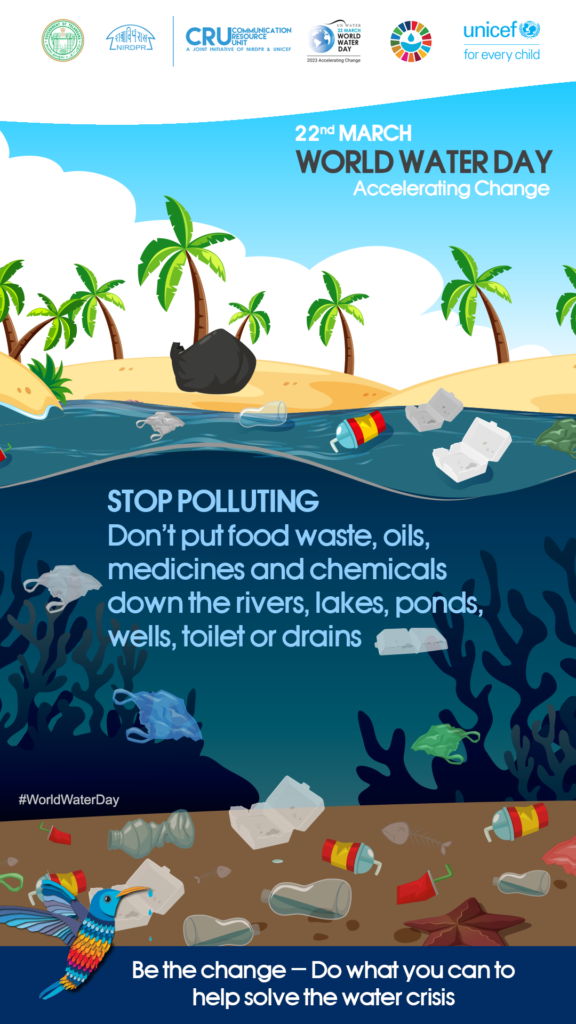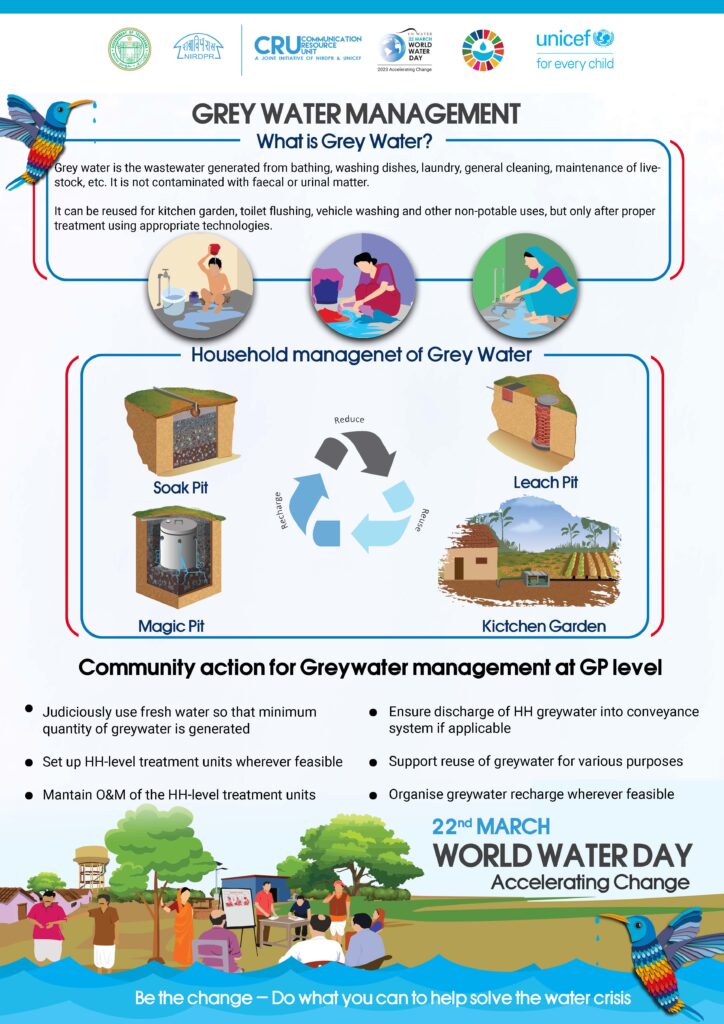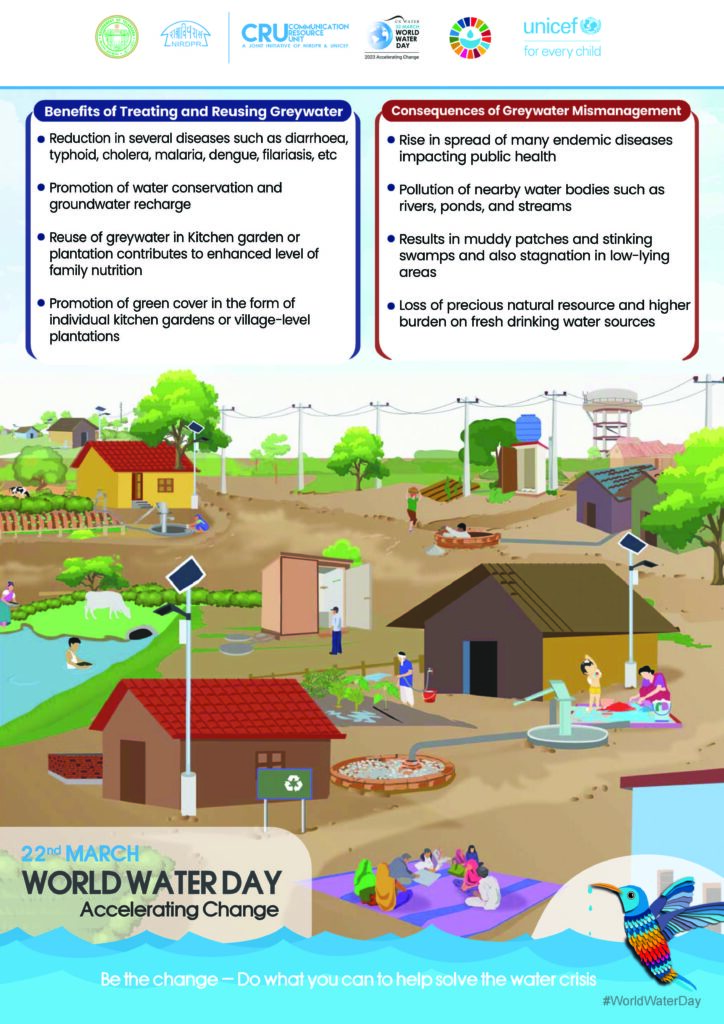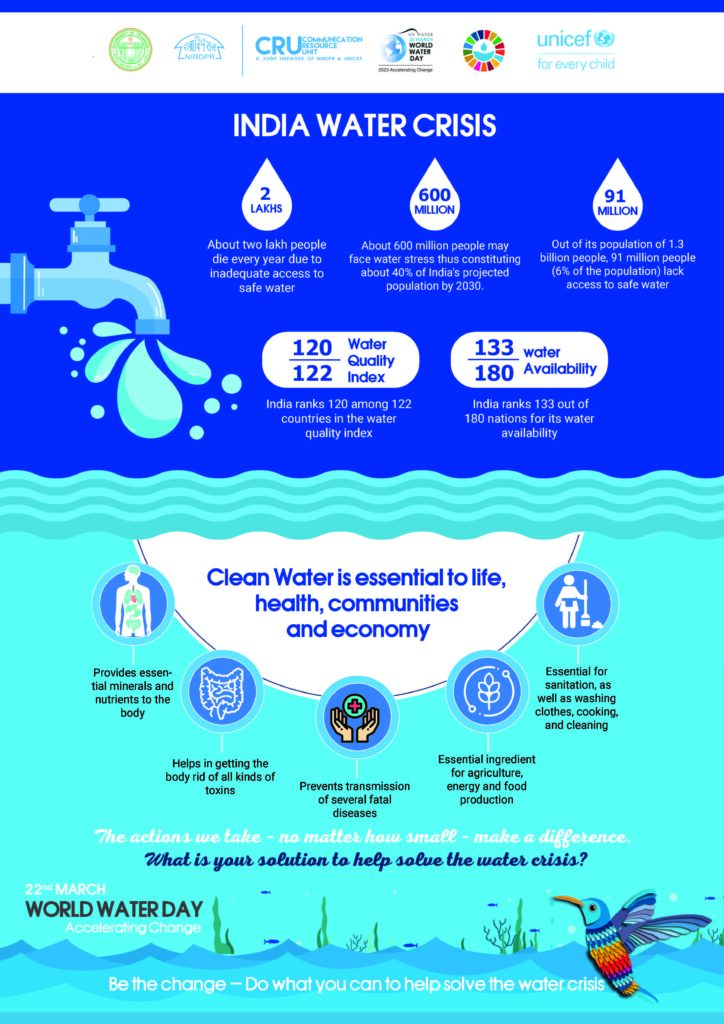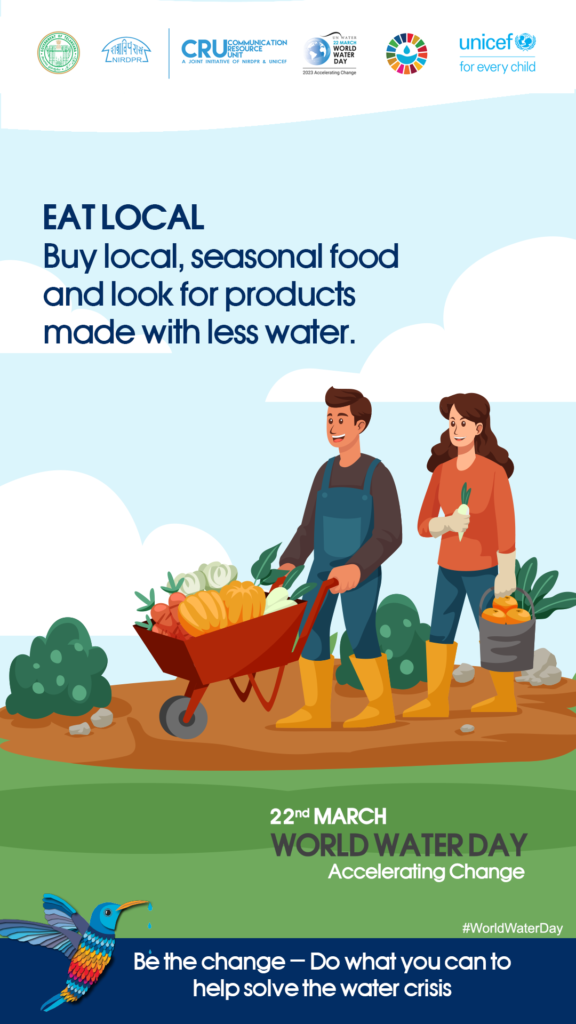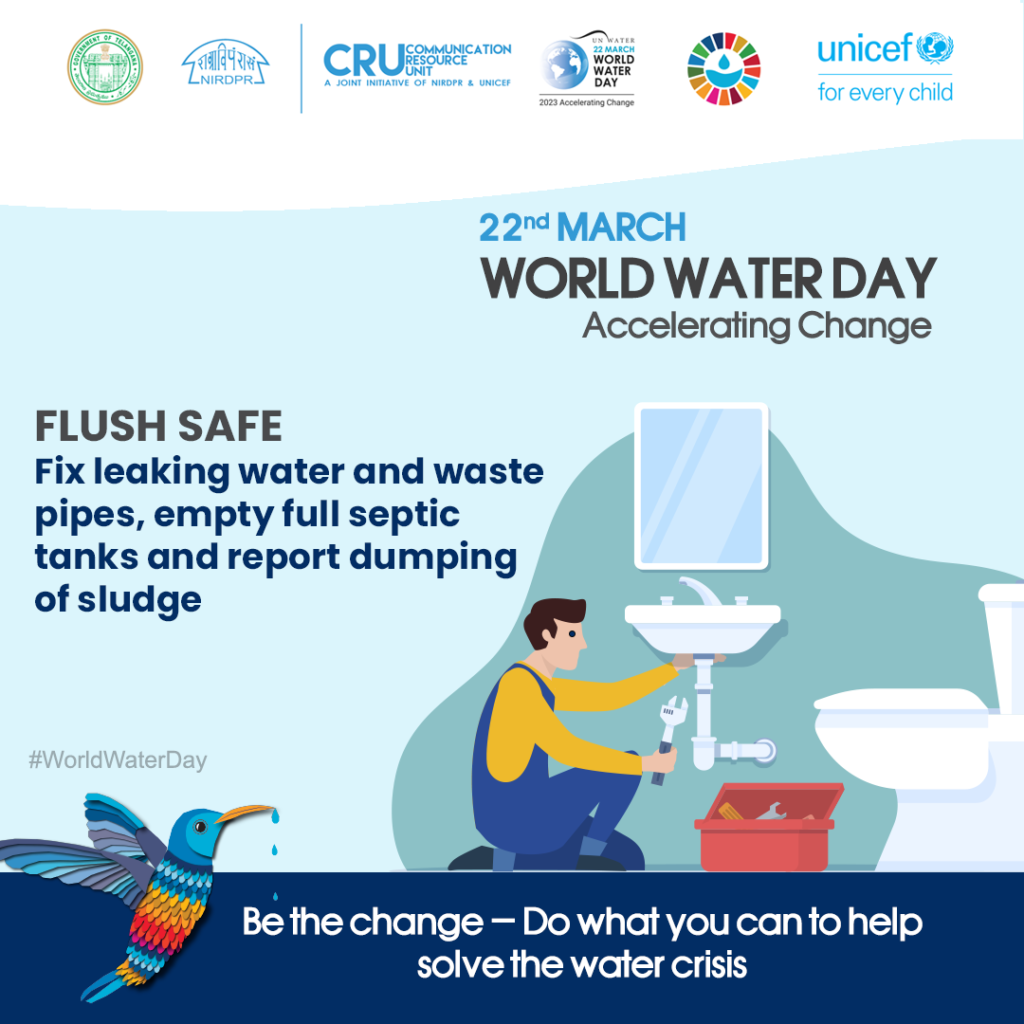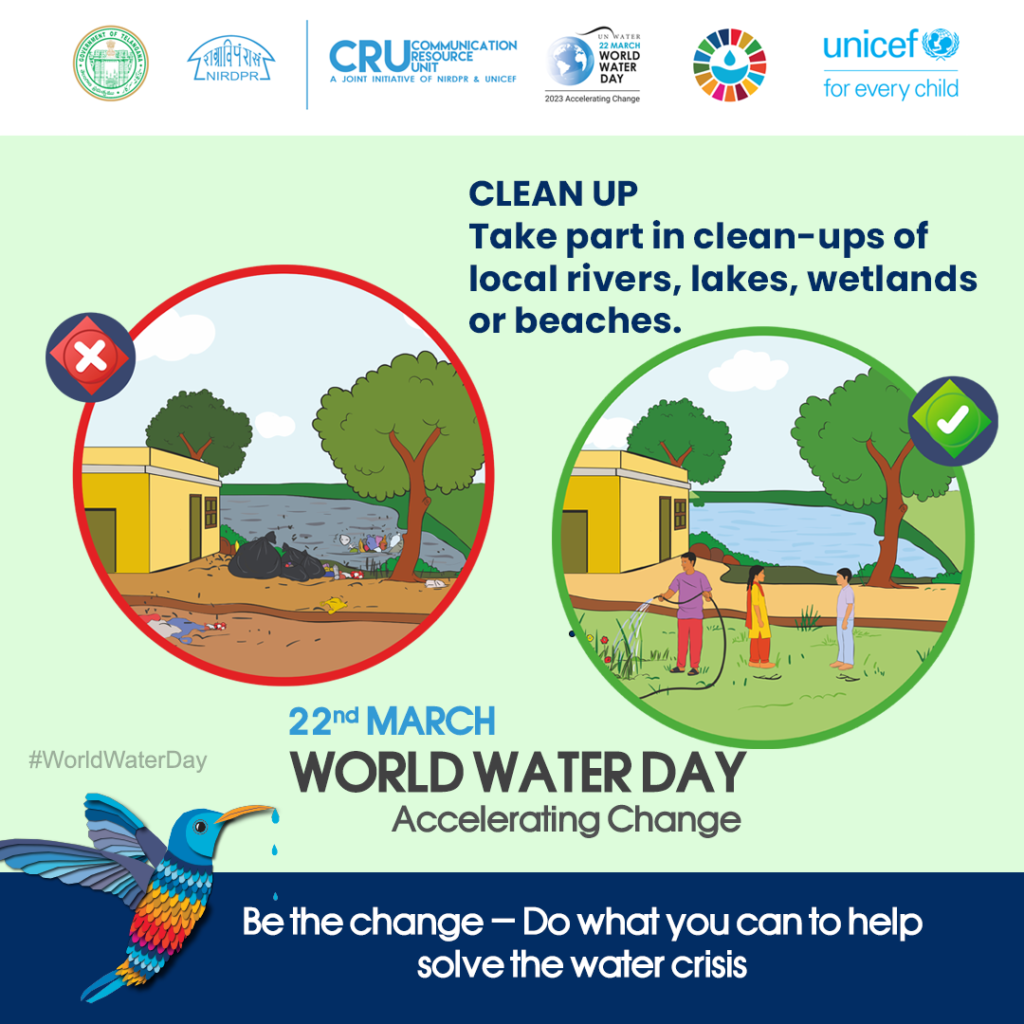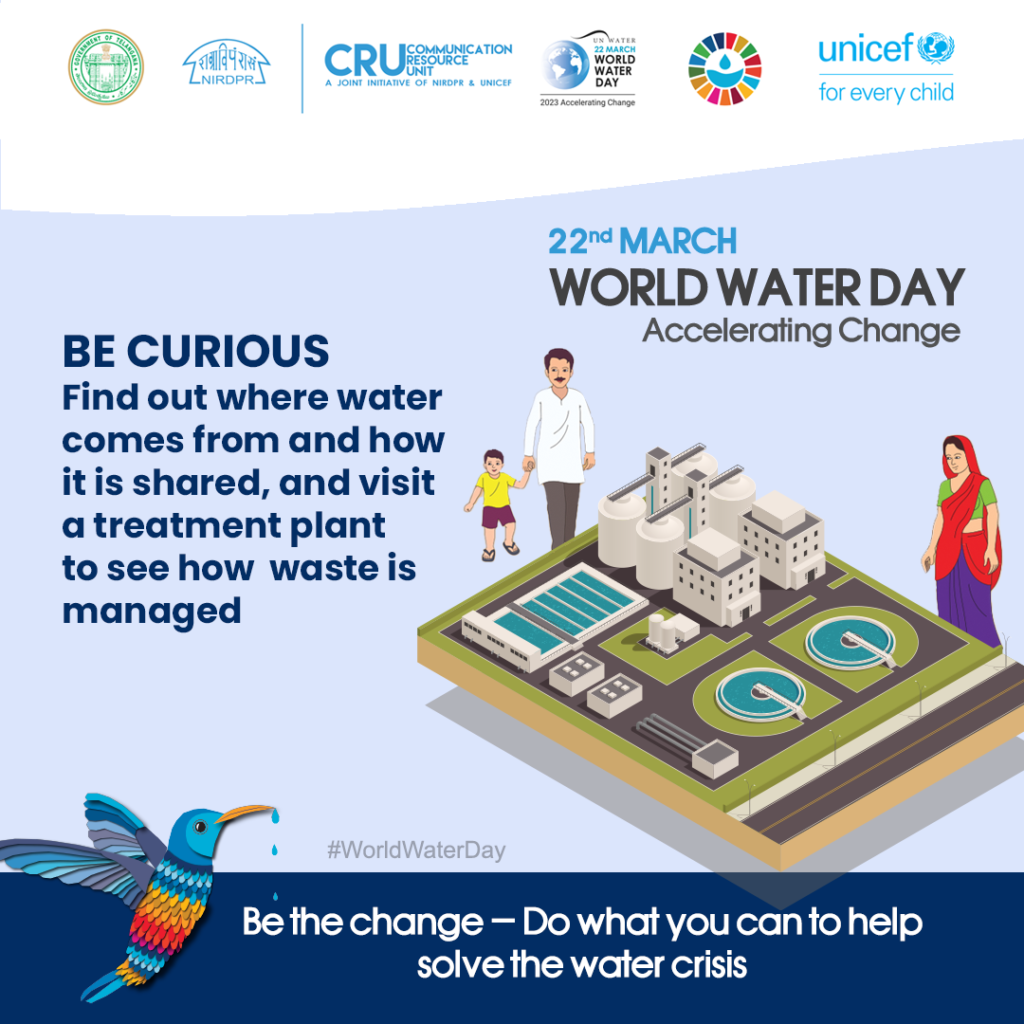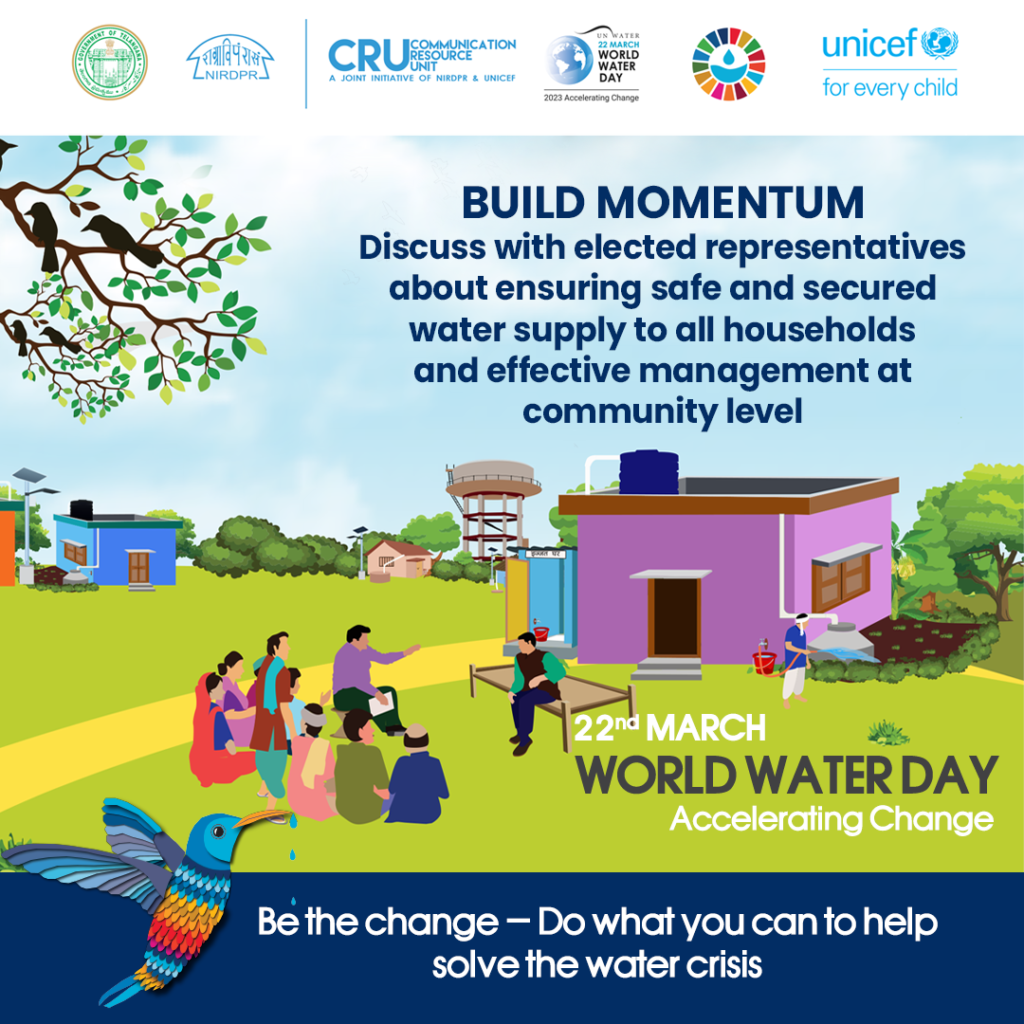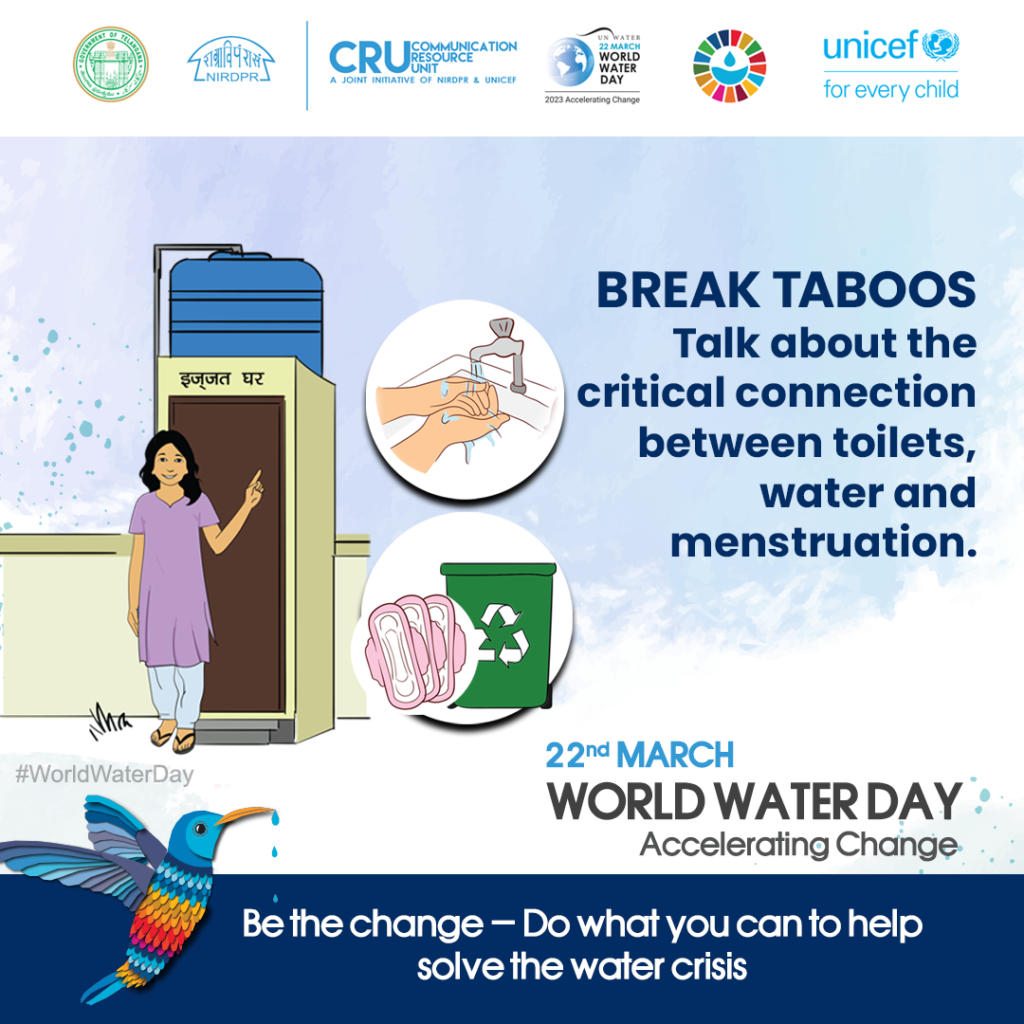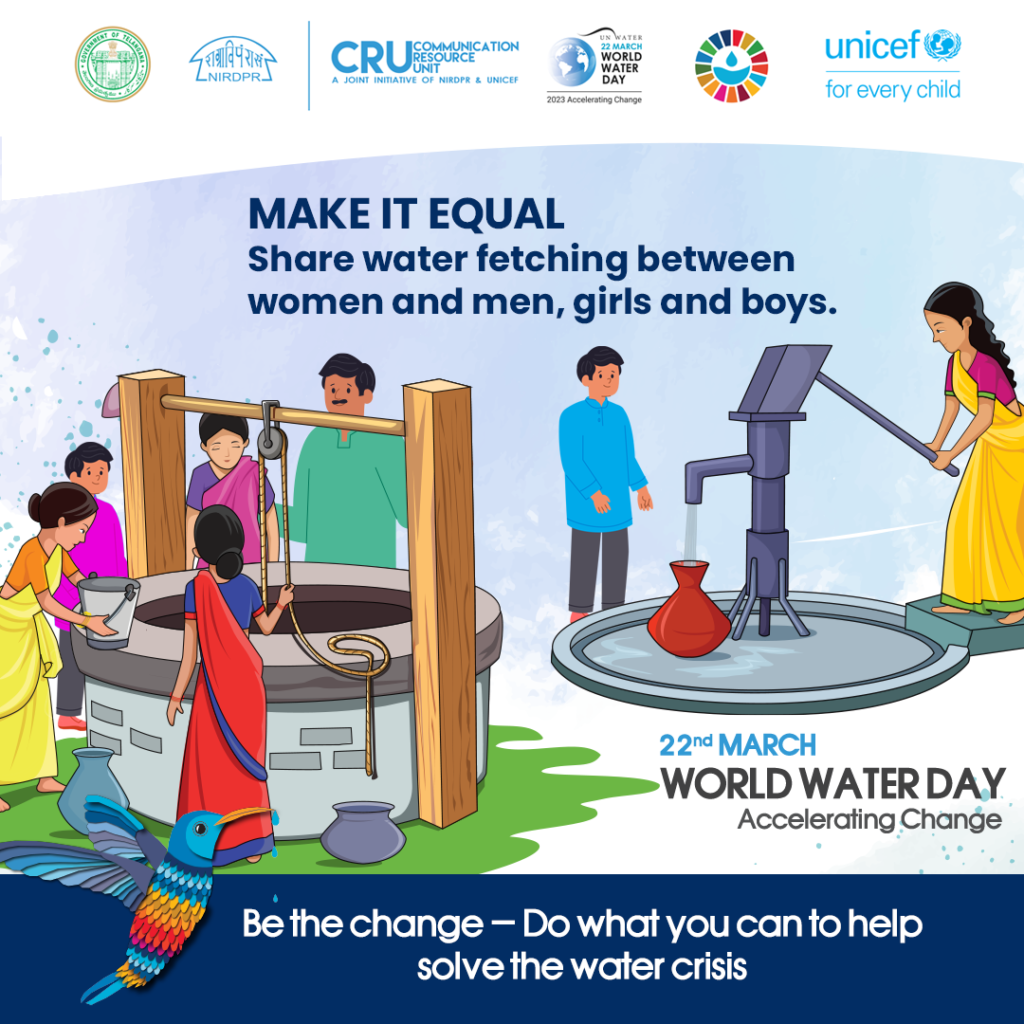
CONTENTS:
COVER STORY: Managing Health Outcomes through Panchayati Raj Institutions
MoRD, NIRDPR – Delhi Branch Organise SARAS Aajeevika Mela – 2023
NIRDPR, ICRISAT Sign MoU to Promote Dryland Crops and Climate-smart Farming in ‘Rurban’ Clusters
CEDFI, CAS Jointly Conduct ToT on Skill Development and Employment Generation in Rural Informal Enterprise Sector
Training on Convergence of PMMSY with Rural Development Programmes
NIRDPR & SIRD, Manipur Conduct Training Programme on Strategies for Management of Solid & Liquid Waste at GP Level
CIAT&SJ, CEDFI Conduct ToT on Entrepreneurship & Sustainable Livelihood Models for Rural Communities
MoRD Official Language Division Officials Visit NIRDPR
Workshop-cum-Training on Deprived Sections and Reachability of the RD Schemes at SIRD, Meghalaya
World Water Day-2023: CRU-NIRDPR Releases Posters
COVER STORY:
Managing Health Outcomes through Panchayati Raj Institutions
Dr. Sucharita Pujari
Assistant Professor, CPGS&DE, NIRDPR
World Health Day (WHD) is observed worldwide on the 7th of April every year. “Health for All” is the theme for World Health Day 2023 which envisions that all people should have good health for a fulfilling life in a peaceful, prosperous, and sustainable world. “Health for all’ is a critical component in the United Nations’ 2030 agenda for Sustainable Development Goals as well, with an overarching emphasis on universal health coverage, and focusing on social, and environmental determinants of health.
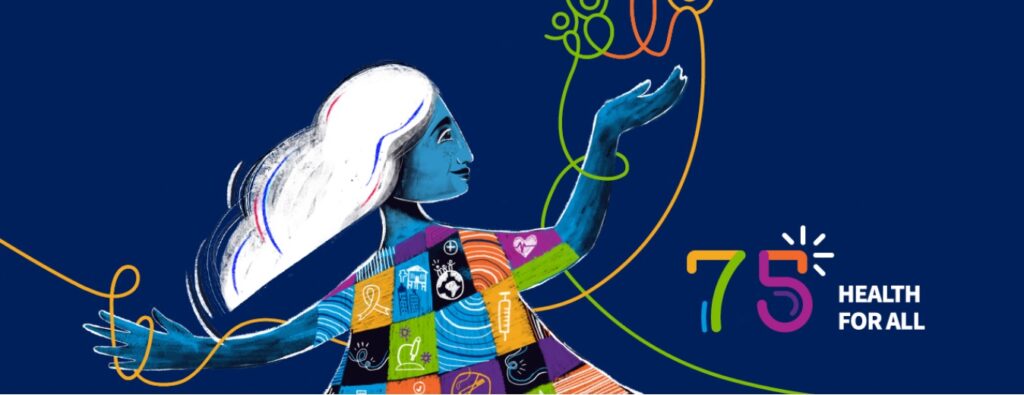
Public health and nutrition, hence constitute important domains within the context of rural development. Though India has made significant progress in health and development indicators globally over the past two decades, it is still ranked among countries with “medium” human development. It is pertinent to note that rural India confronts infectious diseases, nutritional deficiencies, and the challenge of escalating epidemics of non-communicable diseases to a great extent. Concerted efforts and interventions are therefore needed in the area of health to accelerate progress towards the SDG goals and break the intergenerational cycle of poverty in rural India.
According to a report released by the United Nations Development Program (UNDP), India dropped one spot to 131 among 189 countries in the 2020 Human Development Index, which shows that the nation still has a lot to achieve with respect to health, education, and standards of living. The Government of India has made several noteworthy efforts through its various ministries/ line departments and programmes towards achieving the health and development targets of its citizens. However, a critical analysis of India’s current scenario shows some overall challenges in achieving holistic community health and well-being.
Universal Health Coverage
India is committed to providing universal health coverage to ensure that everyone, everywhere should have access to essential healthcare services without facing financial hardship. ‘Ayushman Bharat’, India’s Health Mission, launched in 2018 provides free access to healthcare and financial risk protection for poor and vulnerable families through its two complementary schemes, Health and Wellness Centers and Ayushman Bharat Pradhan Mantri Jan Arogya Yojana (PMJAY).
Despite all, some of the key health challenges in rural India have been limited access to health facilities, insufficient availability of good quality care services within one’s reach, sub-optimal quality of health services, and high out-of-pocket expenditure (OOPE). Health expenditure due to OOPE contributes 8.1 per cent to rural poverty in the country, with the disadvantaged group getting low healthcare access and coverage leading to worsening of health outcomes. A study based on the National Sample Survey Data (1994–2014) estimates that about 55 million people in India were pushed into poverty due to OOPE on healthcare—among them, 38 million fall below the poverty line due to medicine purchases alone.
Analysis of the 5th round data of National Family Health Survey indicates mixed trends for health and nutrition. While on one hand, we see a worsening trend for nutrition indicators, with most States poorly performing in one or more indicators of malnutrition—stunting, wasting, underweight and overweight along with increasing anaemia prevalence, on the other, health outcomes and health service delivery have shown significant improvement across States. A uniform improvement in the infant mortality rate (IMR) and under-five mortality rate has also been observed across many States. As data indicates improvement in some of the nutrition-sensitive indicators, such as access to toilet, safe drinking water, or women empowerment in terms of education or owning a bank account, the gains seem to be contradicted by decreasing trends of child feeding practices and access to adequate and diverse diets leading to food insecurity.
Promoting health requires a sincere effort by making a paradigm shift towards a health-centred approach by creating conditions in which health can thrive by addressing the root causes of diseases and illnesses. This transition begins when it is understood that the consciousness of health begins not in clinics or hospitals but in schools, streets, households and communities. This requires empowering and enabling individual families and communities to make healthy choices and create environments in which people can make those choices.

The important determinants of health are interlinked with class, ethnicity, gender and education level, and the key to achieving Sustainable Development Goals (SDGs) will be in addressing these social determinants of health through people’s participation in decisions affecting their community’s health.
Why Panchayats for Health?
The Gram Panchayat (GP) represents India’s decentralised local self-governing body that envisions people’s rule at the lowest level. Hence, Gram Panchayats play a pivotal role in the governance, planning and implementation of schemes in the villages to ensure socio-economic development in the villages that they govern. The development of any area or community is determined by the Human Development Index (HDI), which is derived from three dimensions, namely (1) Health (life expectancy at birth), (2) Education (mean of years of schooling for adults aged 25 years and more and expected years of schooling for children of school entering age), and (3) Standard of living (gross national income per capita). It is seen that health has one-third weightage in Human Development Index (HDI). Thus, unless there is improvement in the health of people, human development in the Panchayat would not show the desired upward trend. As a decentralised body, it is the GP’s responsibility to take relevant and appropriate measures for people’s health and well-being, and thereby contributing to achieving SDGs.
Role of PRIs in Health Development in Gram Panchayats
Panchayats in India have a decisive role in the programmes for reproductive health, and child health and nutrition through community participation as envisaged in the National Rural Health Mission. The main problems ailing the rural health system today are lack of adequate infrastructure, lack of trained manpower, lack of accountability, and lack of people’s involvement. In this context, the role of Panchayati Raj Institutions (PRIs) has become quite relevant. As the local government in the village, the Gram Panchayat needs to know about different challenges and needs in healthcare so that it can take necessary initiatives to address these challenges and people’s requirements in collaboration with the health functionaries thereby ensuring access of people in the GP area to quality health care. Gram Panchayats should evolve as health-conscious communities with an environment that would sustain and promote improved health conditions for its people.
The roles and responsibilities of a Gram Panchayat in health can be broadly categorised under three headings:
- Making sure that the services necessary for the community or the community is entitled to, are available and are of good quality. This includes both health care services and other public services like drinking water and sanitation, which are essential for health.
- Making sure that all groups within the Gram Panchayat area are able to avail and benefit from health services. Different groups based on caste, class, gender and religion may have different reasons for lack of access to services and the GP needs to be aware of it and appropriate action may be taken. Certain services may be individual-specific like pre-natal check-ups whereas some may be beneficial to whole communities like initiatives to reduce communicable diseases.
- Influencing the governance of the health system, i.e. the GP has a role not only in monitoring the health services but also in setting its priorities and plans for the future with the participation of community members.
To perform its health-related roles, Gram Panchayat should be aware of the health status of people and critical aspects of health in the GP area like the number of deaths of infants, children and women, specifically of girl children and maternal deaths, nutritional status, age at marriage & first pregnancy, and prevalence of diarrhoea, malaria, respiratory infections, tuberculosis, leprosy, etc.
Mapping of High-Risk Marginalised Communities
It is important for the Gram Panchayat to map all the marginalised communities with high risks, such as malnourished children, high-risk pregnancies, TB patients, areas with environmental risk of vectors that can spread malaria, dengue, etc., and families with frequent incidences of domestic violence, etc. The GP can then discuss these issues in the Gram Sabhas and Gram Panchayat meetings to identify specific problems faced by groups/families/individuals. For example, for anaemia amongst women during pregnancy, information about their health and nutrition needs can be shared in Gram Sabha. Gram Panchayat can also ensure that ASHA keeps stock of such cases and provides necessary health support.
Accessing of Social Welfare Schemes
The GP can make sure that the benefits of all social welfare schemes reach the needy in time. For persons like the elderly, single women or widows without any family support or persons with disability, the GP should maintain a list and see to it that they are registered for benefits under a relevant scheme and also receiving it.
Mapping the Environmental Determinants of Health
For the environmental determinants affecting health, the GP would need to map out drinking water sources, frequency of cleaning them, water quality testing etc. It would also need to ensure that all communities have equal access to water. Similarly, in terms of sanitation, it would need to see if any stagnant pools are potential breeding sites for vectors, and which communities living close to such places need special attention. It would also need to see whether any industrial activities affecting the health and welfare of the community are practised in the GP or nearby areas.
Community Sensitisation
Gram Panchayat can also organise talks/ discussions in the GP area by expert NGOs, for community sensitisation on issues like domestic violence, gender discrimination, need for healthy work conditions, need for cleanliness, use of toilets, etc.
Focus Area: Newborn Health
Newborn deaths contribute to nearly 65% of Under-5 deaths in the country. The major causes of newborn deaths in India are Prematurity & LBW (48%), Birth Asphyxia & trauma (13%), Pneumonia (12%), Sepsis (5.4%), Congenital anomalies (4%) and diarrhoea (3%). Though the Gram Panchayat has the responsibility to ensure the effective implementation of maternal and child health services, given the priority for economic activities, poor access to information, and not having a full appreciation of the importance of health needs, the Gram Panchayats have not played an effective role in improving maternal and child health services so far. Elected representatives in the Gram Panchayat can play a vital role in improving MCH services with effective capacity-building training in this regard.
Rural Areas and Age-Related Diseases (ARDs)
Most of the ARDs are higher in rural areas. It is observed that most of the social and environmental determinants of health are not very optimal in rural areas. Frequent use of pesticides in excess accumulates in the bodies through the environment and food. The prevalence of obesity-related diseases is also increasing in rural areas. The most burdensome diseases of the elderly are musculoskeletal disorders that include problems of the musculoskeletal system, which is evident from frequent complaints of low back pain, knee pain, neck pain or some other joint pain made by the elderly. In rural areas, physical work in excess takes a heavy toll on the joints of older people leading to some or other musculoskeletal disorders. Similarly, cardiovascular diseases and hypertension are also increasing among the rural population. It is equally important that Panchayati Raj functionaries at the grassroots level are sanitised about their issues so that local planning for improving community health can be done effectively.
Health of Persons with Disabilities and the Role of Gram Panchayat
Disability is an important public health problem, especially in developing countries like India. The problem will increase in future because of the increase in non-communicable diseases and change in age structure with an increase in life expectancy. In India, majority of the disabled persons reside in rural areas where accessibility, availability and utilisation of rehabilitation services and its cost-effectiveness are the major issues to be considered. Impaired mobility, low economic status and lack of infrastructural facilities present multifold challenges for persons in our rural settings.
The GP can take initiatives for empowering the Persons with Disability (PWDs) so that they can enjoy all the rights provided to them under the Persons with Disabilities (Equal Opportunities, Protection of Rights and Full Participation) Act, 1995 and take an active part in the overall development process of the community.
Some of the initiatives the GPs can take during the planning process are given below:
- Identify children/persons with disability in the Gram Panchayat area and link them with the existing development/social security programmes being implemented by the Gram Panchayat itself or upper tiers of Panchayats or other Line Departments.
- Ensure disabled persons-friendly facilities in public places like Panchayat Ghar, schools, health facilities at GP level, parks, etc.
- Ensure inclusion of their health issues in public discussion forums and processes of governance like meetings of Gram Panchayat, Gram Sabha, Ward Sabha, etc., for identification for the annual GP planning processes and identification of beneficiaries for healthcare.
- There may be vulnerable persons or groups specific to a State or a local area with distinctive health issues and needs. Gram Panchayat would need to pay them special attention, identify their health issues and do the needful for linking them with the health support system accordingly.
- The Gram Panchayats have a role to play in crucial areas such as mental health, alcoholism & drug addiction and prevention of HIV/ AIDs.
Experiences on PRI Involvement in Health – Good Practices as Documented Across States
It has been observed that the involvement of local self-governance institutions in Kerala scaled up the number of sub-centres, primary health centres and improved service facilities at the PHCs, CHCs and district hospitals in the last 15 years. Another study in Karnataka showed improved attendance of doctors and paramedical staff under the constant monitoring of local leaders in many primary health centres and other hospitals. In Madhya Pradesh, it was found that with proper orientation and training, PRI members are in a position to actively involve in monitoring the functioning of healthcare institutions for the benefit of the poor. Further, in Kerala, it was observed that devolving authority and resources to Panchayats has really resulted in the creation of structures of participatory governance. Gram Sabhas or Ward Sabhas and Task Force actually influenced budgetary outcomes. Thus, many of the socioeconomic determinants of health can be tackled at the Gram Panchayat level itself simply by making people aware of the importance of having good health, hygienic practices, busting myths about health, creating awareness about existing health and social welfare schemes, and by proper utilisation of frontline workers available at GP level.
Way Forward
The well-being of the villagers depends to a great extent on the efficacy of the Gram Panchayat. Further, it is expected that the Sarpanch would play a crucial role in the provision of these services by her/his initiative and interest. The way forward lies in effective implementation and monitoring of government health schemes in the community, scaling up of ongoing initiatives, involving greater participation from all sections/social groups in the community leading to an enabling environment towards the achievement of universal health coverage through a multisectoral approach. Also, the role of technology-enabled platforms like e-Sanjeevani along with digitisation and artificial intelligence at scale would certainly help meet the last-mile challenges of healthcare delivery in India.
(Inputs have been taken from manuals published by NHSRC, WHO reports, reports published by MoHFW, and articles on Community Health and Local Governance)
MoRD, NIRDPR – Delhi Branch Organise SARAS Aajeevika Mela – 2023
‘SARAS Mela’ is a noteworthy initiative under the Deendayal Antyodaya Yojana – National Rural Livelihoods Mission (DAY-NRLM) of Ministry of Rural Development, Government of India which aims to provide a platform to rural artisans to showcase their skills, sell their products, build links with bulk buyers and develop a market for themselves nationally/internationally.
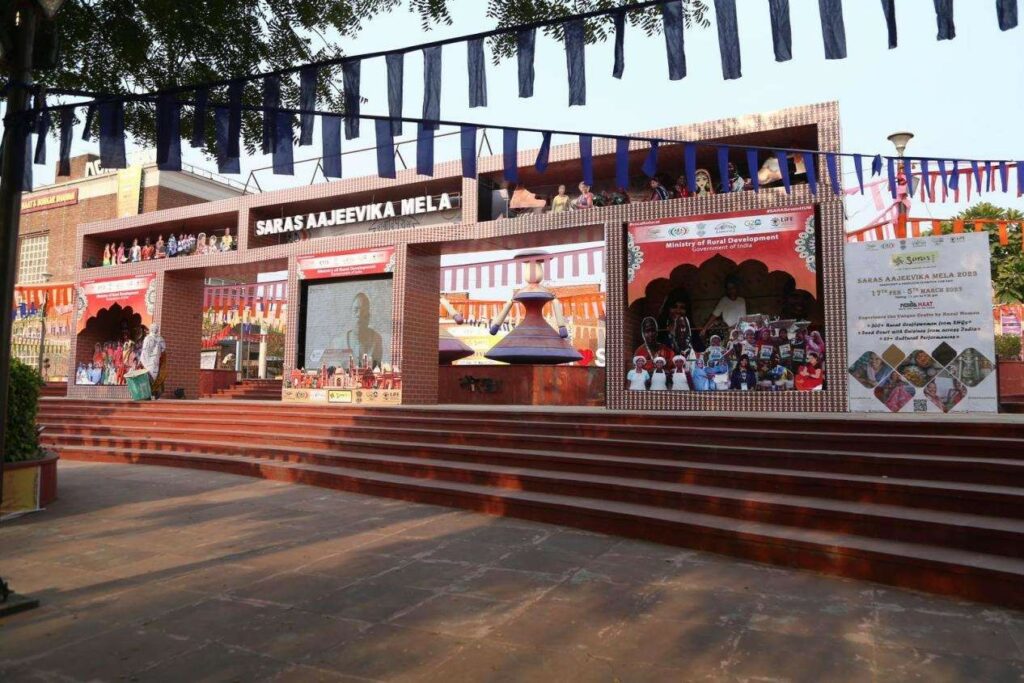
The third edition of the SARAS Aajeevika Mela, with a focus on art, craft and culture was organised by the Ministry of Rural Development and National Institute of Rural Development and Panchayati Raj (NIRDPR) – Delhi Branch, at Noida Haat, Noida, Uttar Pradesh, from 17th February to 5th March 2023. Around 400 rural craftswomen of 250 Self-Help Groups (SHGs) from 30 States/UTs across the nation participated in the exhibition and sold their products by setting up 219 stalls.


Hon’ble Union Minister for Rural Development and Panchayati Raj Shri Giriraj Singh inaugurated the Mela on 18th February 2023 and delivered the inaugural speech. Sadhvi Niranjan Jyoti, Hon’ble Minister of State for Rural Development and Consumer Affairs, Food and Public Distribution and Shri Faggan Singh Kulaste, Hon’ble Minister of State for Rural Development and Steel were also present and addressed the audience. Shri Shailesh Kumar Singh, Secretary (Rural Development), Shri Charanjit Singh, Additional Secretary (RL), MoRD, Smt. Neeta Kejriwal, Joint Secretary (RL), MoRD, Shri Raghvendra Pratap Singh, Director (RL), MoRD and other senior officers/dignitaries were also present.

This exhibition-cum-sale under the brand name of ‘SARAS Aajeevika’ brought to its audiences a wide range of products handcrafted by the rural artisans/ craftswomen/beneficiaries of SHGs promoted under the DAY-NRLM Scheme of Ministry of Rural Development.
The details of the main products brought by SHGs in three different categories are as under:
Handicraft: Bamboo art and water hyacinth products from Assam, Madhubani Paintings and Sikki Craft from Bihar, Candles, Soap, Wooden nameplates from Chhattisgarh, Wooden toys, Decorative items from Goa and Gujarat; Metal art, Terracotta items, Artefacts from Haryana, Artificial flower art from North East, Jewellery from Karnataka, Footwear from Maharashtra, Sabai handicrafts, Brass item, Golden grass products from Odisha; Bangles from Bihar; Jute handbags from West Bengal.

Handloom: Silk Saree, Cotton Sarees, Handloom Cloth, Cotton Suit from Odisha, Bihar and Chhattisgarh, Bed sheets from Uttar Pradesh, Kantha Stitch Sarees and Dress Materials of West Bengal; Exclusive sarees of Telangana and Kerala, Woollen and pashmina shawls of Jammu & Kashmir; Dress materials, Woollen shawls and Jackets from Uttarakhand, Woollen shawls of Himachal Pradesh; Handcrafted Jutties and Mojaries, Leather items of Rajasthan, Leather lamp Sheds, Painting and Wooden craft of Andhra Pradesh.
Food items: Natural food items, Gram flour, Rice, Cashew Nut, Organic pulses from Chhattisgarh and Jharkhand, Spices and Coffee from Kerala, Tea leaves from Sikkim, Organic vegetables and spices from Uttarakhand, Medicinal herbs, Rice and Honey from Uttar Pradesh and Mahua ladoo from Chhattisgarh, etc.

The SARAS Gallery at the Mela featured carefully selected products, including Bed linens, brass objects, clay lamps, wooden toys, carpets, furniture, ornamental objects, lanterns, pickles, jam, brass figures, leather bags, handmade masks, etc., made by underprivileged women who are a part of SHGs across India. This Gallery, a retail establishment with a purpose, sells genuine goods that have been gathered at an affordable cost. The distinctive niche crafts produced by women’s SHGs are of the highest calibre, without flaws, environment-friendly, handcrafted, and possess exquisite craftsmanship, traditional features, as well as some distinctive characteristics, such as ecological specificity, cultural specificity, traditional features, or mythological aspect.
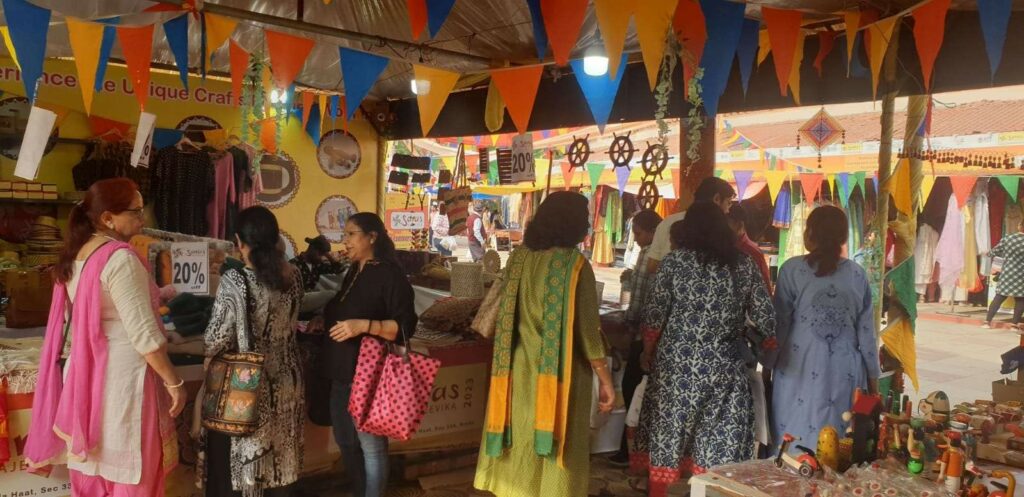
Kudumbashree, the state poverty eradication mission of Kerala, installed 25 food stalls from various states across the country at the India Food Court to showcase the diversity of India’s ethnic cuisines from nearly 18 States prepared and served by SHG members.

During the Mela, the NIRDPR-Delhi Branch organised four workshops for capacity building of SHG members in e-marketing, social media marketing, designing & packaging, managing consumers, communication skills, etc. This included a session on opportunities & challenges for marketing millets through SHGs.

National Institute for Entrepreneurship and Small Business Development (NIESBUD) under the Ministry of Skill Development and Entrepreneurship, organised a three-day workshop for artisans/nano enterprises for scaling up their business activities from 27th February to 01st March 2023 in coordination with NIRDPR Delhi Branch. Dr. Poonam Sinha, Director (NIESBUD) welcomed Ms. Hena Usman, Joint Secretary & Additional Director General (NIESBUD), Ministry of Skill Development and Entrepreneurship who visited Noida Haat, Noida on the final day. She addressed the participants, gave concluding remarks and distributed certificates.

The Council of Scientific & Industrial Research – Central Food Technological Research Institute (CSIR-CFTRI) under the Ministry of Science & Industrial Research, organised three workshops on opportunities and processes related to food technologies and millet products, its packaging and the machinery ready for its commercialisation.

Partrakar Didis from Jharkhand working under the DAY-NRLM scheme were invited to the Mela. Banking Correspondents (BC) from Jharkhand participated in the event. BC Sakhis facilitated the artisans as well as the visitors to deposit and withdraw cash within the mela venue. The total sale reported in 17 days comes to Rs.9.21 Crore from all the stalls including India Food Court.
Empanelled artists of Nodal Haat Agency performed cultural programmes such as folk dances and songs of various States, puppet shows, etc., throughout the event.
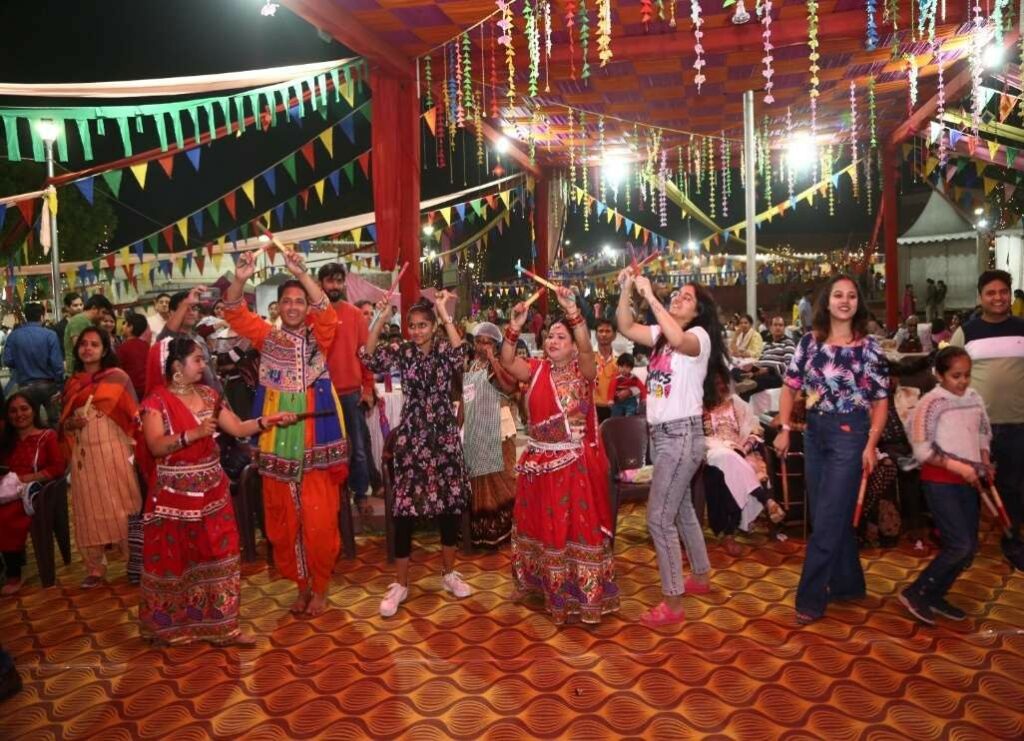
The closing ceremony of SARAS Aajeevika Mela was held on 05th March 2023 and certificates, mementos were distributed to SHGs, Food Court SHGs, State Coordinators, BC Sakhis, Patrakar Didi, etc.
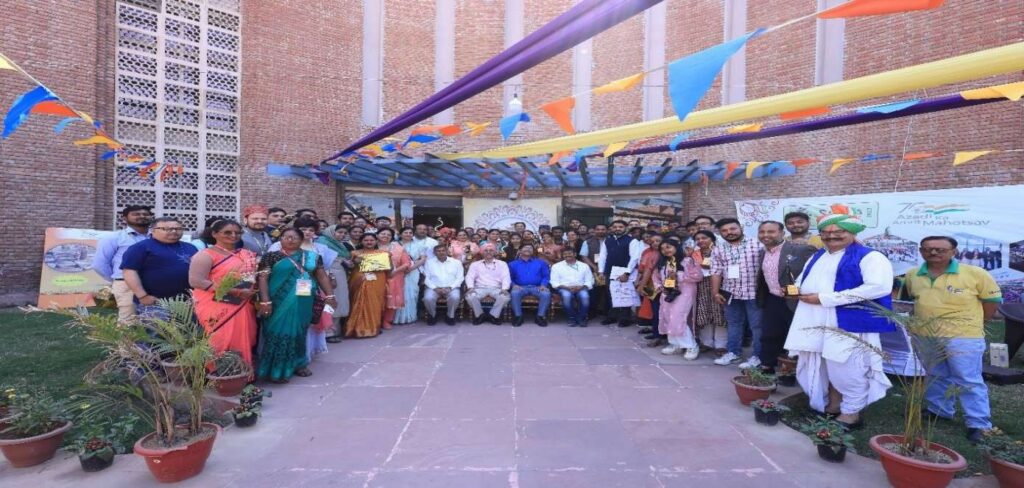
Shri Charanjit Singh, Additional Secretary (RL), Shri R.P. Singh, Director (RL), Shri Vinod Kumar, Under Secretary (RL), MoRD and other officials were also present on the occasion.
NIRDPR, ICRISAT Sign MoU to Promote Dryland Crops and Climate-Smart Farming in ‘Rurban’ Clusters
- The partnership between NIRDPR and ICRISAT is expected to have a significant impact on rural development, poverty alleviation, and food security at the village level. The two institutions are committed to leveraging each other’s strengths to achieve their common goals and create a better future for ‘rurban’ communities in Asia and Africa.

The National Institute of Rural Development and Panchayati Raj (NIRDPR) and the International Crops Research Institute for the Semi-Arid Tropics (ICRISAT) signed a Memorandum of Understanding (MoU) to strengthen evidence-based research and capacity building on critical development issues.
The MoU, signed on March 13 2023, aims to promote collaboration between the two premier institutions in areas such as climate change adaptation, rural entrepreneurship development, value chain development, sharing international best practices, scaling-up of identified agricultural and rural technologies, and livelihood development.
Under the agreement, the two institutions will focus on different collaborative activities by sharing each other’s strengths, including developing ‘Rurban’ clusters for ICRISAT mandate crops through value chain development, encouraging rural incubation and entrepreneurship development by integrating with National Rural Livelihoods Mission (NRLM) activities. Enhancing the value of new generation watersheds through climate-proofing of Gram Panchayats in India and promoting international best practices for poverty alleviation through agriculture and rural development programs are also included.

Speaking on the occasion, Dr. G. Narendra Kumar IAS, Director General, NIRDPR, emphasised that the collaboration between the two institutions is very important in the background of international opportunities and enabling exports of agri-products from dryland areas.
“The technical competence of ICRISAT in research and development on high-yielding varieties and related value-added products, and the strength of NIRDPR in creating business opportunities and marketing support through self-help groups (SHGs) under NRLM across the country, will act in synergy to transform rural livelihoods,” said Dr. Narendra Kumar.
Dr. Jacqueline Hughes, Director General, ICRISAT, expressed her desire for the two institutions to work together for Africa, as they have several commonalities in terms of their vision, mission, and focus areas.
“Let us work together for Africa and share the facilities that the two of us have in the region and not duplicate them. The MoU is a good starting point. Specific work plans, projects, and related funding need to be discussed down the line,” said Dr Hughes.

The MoU signing ceremony was attended by prominent members from both institutions. Prof. Ravindra S. Gavali, Dr. M Srikanth, Dr. K. Krishna Reddy and Dr. Kathiresan represented NIRDPR, whereas ICRISAT staff Dr. Sean Mayes, Dr. Victor Afari-Sefa, Dr. M L Jat and Dr. Hari Kishan Sudini attended.
CEDFI, CAS jointly Conduct ToT on Skill Development and Employment Generation in Rural Informal Enterprise Sector
The Indian economy has been witnessing a series of persistent socio-economic crises since the emergence of the COVID pandemic. Undoubtedly, the crisis has been much pronounced for the vast informal economy of India, which has a significant contribution of 50 per cent to the GDP and employs more than 90 per cent of the country’s labour force. This is corroborated by an ILO 2018 Report titled ‘Women and men in the informal economy: A statistical picture’ (third edition) stated that 81 per cent of the total employment was in the informal sector, also known as the unorganised sector or the shadow economy. While the size of the unorganised sector has been contracting gradually, the share of informal sector workers within the organised sector (as contract/casual labourers) has been on the rise. Accounting for these trends, the proportion of informal workers in the total participating labour force stands at roughly 92 per cent. In the event of reverse migration from urban to rural areas triggered by prolonged pandemic lockdowns, and automation anticipated to substantially substitute menial unskilled and semi-skilled work in a country where the majority population resides in rural areas, understanding the nature of rural informal enterprise sector and employment generation therein through skill development is a dire prerequisite for ensuring sustainable livelihoods.
Against this backdrop, the Centre for Entrepreneurship Development and Financial Inclusion (CEDFI) and Centre for Agrarian Studies (CAS), NIRDPR jointly organised a five-day ToT programme on ‘Skill Development and Employment Generation in Rural Informal Enterprise Sector’for development professionals to equip and empower the rural informal entrepreneurs to upgrade their knowledge and approach to identify and set up resilient entrepreneurial ventures or scale up the existing ones and to leverage the local employment opportunities for the rural youth, women and marginalised communities.
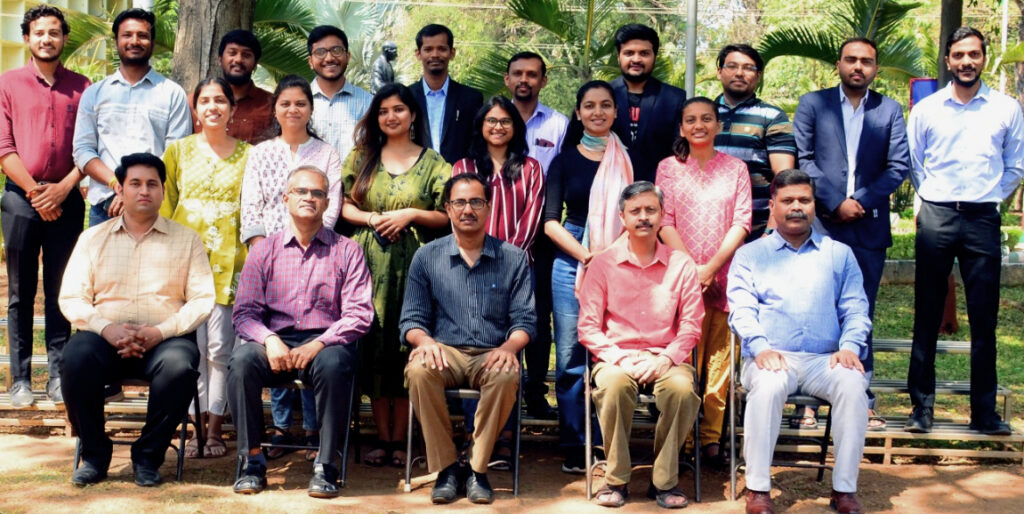
The training programme witnessed a comprehensive discourse during the sessions encompassing employment and skill challenges in rural India, key pathways towards formalisation of the rural informal enterprise, issues on regulatory, compliances and labour laws, emerging challenges faced by informal sector enterprises amidst the pandemic, the gender dimensions of informal sector, institutional support and government schemes for employment generation in rural areas, diffusion of rural technologies, public employment programmes: a case of MGNREGA, value chain analysis, collectives and aggregation models: case of FPOs and empowering entrepreneurship and sustainable livelihood through psycho-social development. The emphasis was laid on forging convergences across several departments and utilising District Skill Committees chaired by the District Collector as a potential platform for the promotion of entrepreneurship and skill development through several schemes, undertaking scoping studies for identification of livelihood opportunities, empowering of SHGs through division of work across the value chain of a product instead of all individual members focussing on the final product, capacity building of frontlines such as Gram Panchayat functionaries and Community Resource Persons (CRPs) under NRLM, importance of entrepreneurial skills and psycho-social development, adoption of cost-effective technologies for rural micro-entrepreneurship development, the significance of SHGs and FPO collectives and aggregation models, targeted mobilisation for skilling programmes among other key discussion points.
The training programme aimed at developing our understanding of the informal enterprise sector and its various issues such as skill, technology, marketing and finance. Moreover, the sessions underscored the importance of formal institutions in supporting the transition of informal enterprises to the formal sector, expansion of the scale of operation and generation of local employment. Further, the training deliberated on the role of government schemes towards skill development and employment generation and policy implementation challenges in rural areas. The sessions were delivered by external and internal resource persons having expertise in their respective thematic areas.
The training programme followed an interesting pedagogy with field visits, case studies, power walks, interactive games, experiential learning and group presentations by the participants besides the conventional classroom-based learning. The programme coordinators and the faculty encouraged dialogue through questions and extensively engaged with individual field experiences of the attendees. Participants were taken for two exposure visits, i.e. to Rural Technology Park (RTP) at NIRDPR where they got an opportunity to see live demonstrations of more than 20 livelihood models such as beekeeping and honey processing, cultivation of aromatic plants and essential oils extraction, food processing of soya and millets, vermicompost production, biogas production, mushroom cultivation and processing, biopesticides and neem-based production, herbal cosmetics and handmade paper products among others. The participants also engaged with the entrepreneurs managing the units about their entrepreneurial journey and market linkage challenges.
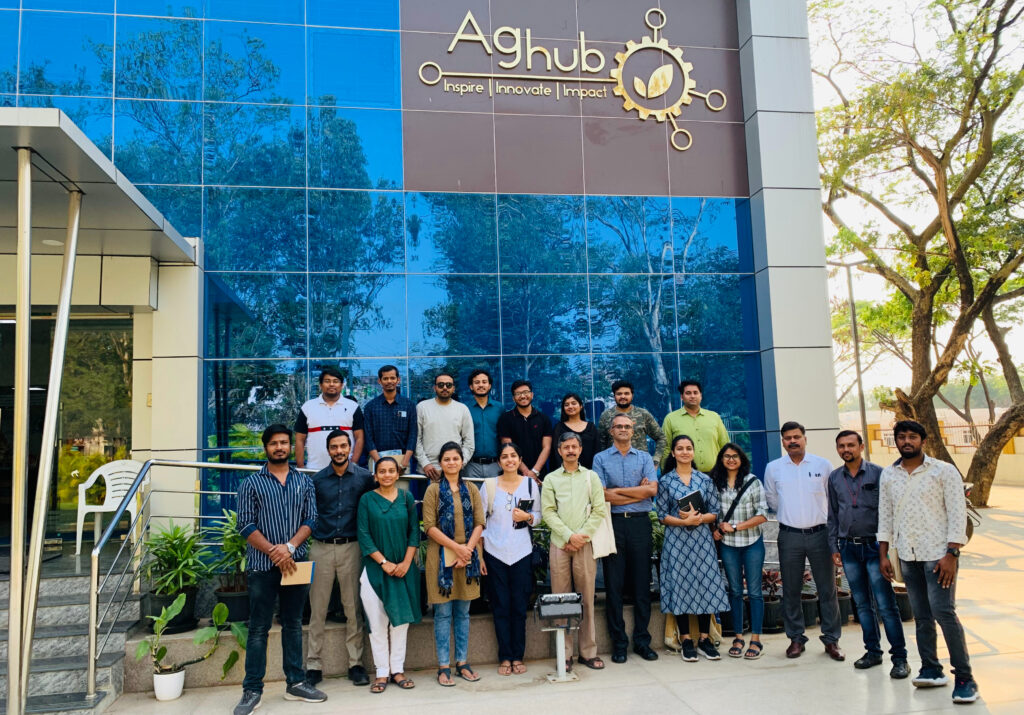
Secondly, the participants were taken to AgHub, a first-of-its-kind incubator designed in a hub and spoke model with its innovation hub at PJTSAU, Hyderabad that caters to food and agritech start-ups and aspiring student entrepreneurs. AgHub at PJTSAU aims to create an inclusive agri-innovation and entrepreneurial ecosystem across the State of Telangana through Ideation-Incubation-Innovation bridges among the start-ups, farmers/FPOs along with the promotion of translational research across academia, students and rural communities.
The programme was attended by 23 participants from across the country. These were carefully shortlisted from more than 250 nominations/applications received through an online registration process. The training cohort was a diverse group and the participants included faculty members from SIRDs, ETCs, RSETIs, officials and Mahatma Gandhi National Fellows, Young Professionals from SRLM, and representatives from NGOs and CSR affiliates. The programme concluded with group presentations by the attendees on key takeaways from the training programme that can facilitate meaningful impact on rural development endeavours of the participants and potential collaboration with NIRDPR for strengthening the grassroots ecosystem of entrepreneurship and skilling for the rural informal economy. On a parting note, detailed online feedback was collected from the participants through the Training Management Portal (TMP) and the programme coordinators also sought their verbal feedback on other potential areas to be covered and the scope of improvement in training delivery for enhancing the quality of ToT programmes in this domain going forward.
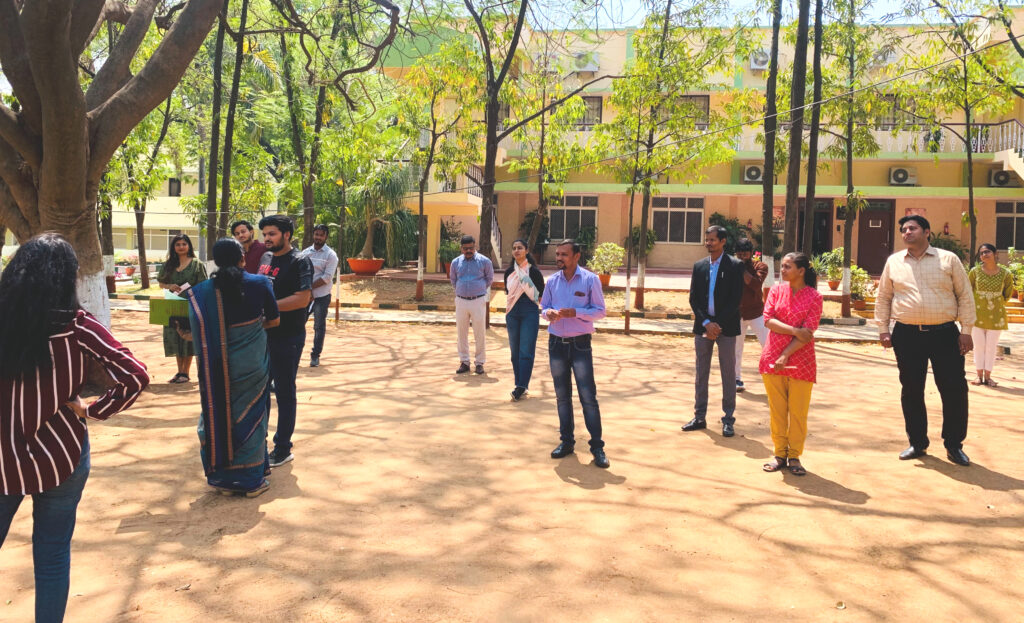
The five-day ToT was jointly coordinated by Dr. Partha Pratim Sahu, Associate Professor, CEDFI and Dr. Surjit Vikraman, Associate Professor & Head, CAS, NIRDPR.
(Note: This report is prepared by one participant of the said programme, Ms. Lata Gidwani with inputs from Dr. Partha Pratim Sahu)
Training on Convergence of PMMSY with Rural Development Programmes
Foreseeing the immense potential for the development of fisheries and for providing focused attention to the fisheries sector, the Government in its Union Budget, 2019-20 has announced a new scheme called the Pradhan Mantri Matsya Sampada Yojana (PMMSY) which has a large scope of raising economic wellbeing of the rural population. Since agriculture and other allied sectors contribute to the livelihood and employment generation of people living in rural areas, it is vital that the Gram Panchayats, State Rural Livelihood Missions and other stakeholders also need to converge their flagship programmes with PMMSY for the betterment of rural households.

As a part of instigating and instilling the scope of fisheries technologies in enhancing the economy of the rural livelihood for a sustainable living, the Centre for Natural Resources Management, Climate Change and Disaster Mitigation, NIRDPR hosted a training programme from 20-21 March 2023, which turned out to be an excellent platform for the exchange of ideas and knowledge in a more integrated manner to explore the range of convergence of MGNREGS and NRLM with PMMSY & Centrally sponsored schemes. Nearly 28 participants from various States took part in the ToT.
Dr. Suvarna Chandrappagari, IFA, Chief Executive, National Fisheries Development Board inaugurated the programme and gave a lecture on salient features of PMMSY, and its scope for linkage with Rural Development Programmes like MGNREGS and NRLM. Smt. A. V. Madhuri, Sr. Executive from NFDB and Dr. Ganesh Kumar from ICAR-NAARM delivered their lectures on Funding Pattern, Institutional Framework, mode of implementation and income and employment aspects and livelihood security under PMMSY in rural areas.

The Centre brought together a host of cost-effective methods of fish culturing techniques blending the traditional and modern scientific approaches to familiarise participants with the scope of pisciculture to improve the quality of life of rural households. Orienting the participants on harnessing fisheries’ potential in a sustainable, responsible, inclusive and equitable manner was the prime objective of the training programme. Group activities served as the best part of the training enabling brainstorming and exchanging ideas on designs in advocating the new scientific methods of fish culture for future convergence with MGNREGS and NRLM in a multisectoral approach.
It is evident that fisheries and aquaculture provide livelihood to about 16 million fishermen in India and fish farmers at the primary level and almost twice the number along the value chain. Being an affordable and rich source of animal protein, fish is one of the healthiest options to mitigate hunger and malnutrition. However, over the years, the fisheries sector in India shows impressive growth in fish production with an average annual growth of 7.53 per cent during the last five years and stood at an all-time high of 137.58 lakh metric tonnes during 2018-19. Government of India Reports, 2020 indicate that the export of marine products stood at 13.93 lakh metric tonnes and was valued at Rs.46,589 crore (USD 6.73 billion) during 2018-19.

Malnutrition is a major concern to be addressed in India as data shows 36 per cent of children under age five are stunted (short for their age), 19 per cent are wasted (thin for their height), 32 per cent are underweight (thin for their age) and 3 per cent are overweight (heavy for their height). Keeping in view the state of India’s malnutrition and the need for harnessing the marine fisheries’ potential for food, nutrition, employment and income of millions of people in the rural sector, it is essential that sustained and focused attention is given to the fisheries sector through policy and financial support and equip the rural livelihoods lives independently.
During the two-day programme, the participants were imparted knowledge on the following topics:
- Indian Fisheries, harvest and post-harvest
- Criteria for selection for species culture
- Design and construction of fish farm
- Control of weed, predatory and weed fishes
- Nursery pond management
- Stocking, feeding, harvesting, pond management stocking seed, etc.
- Culturing methods of shrimp, fin fishes
- Funding and implementation
Dr. Subrat Mishra, Associate Professor and Dr. Ravindra S. Gavali, Professor & Head, Centre for Natural Resources Management, Climate Mitigation and Disaster Management, NIRDPR, Hyderabad coordinated the programme.
NIRDPR & SIRD, Manipur Conduct Training Programme on Strategies for Management of Solid & Liquid Waste at GP Level
The National Institute of Rural Development and Panchayati Raj, Hyderabad, in association with SIRD, Manipur conducted a five-day training on ‘Strategies for Management of Solid and Liquid Waste at Gram Panchayat Level.’ Forty-seven participants from Imphal East, Imphal West and Bishnupur districts, who are serving at district, block, and GP levels, participated in this training. The programme comprised in-house sessions and field visits.
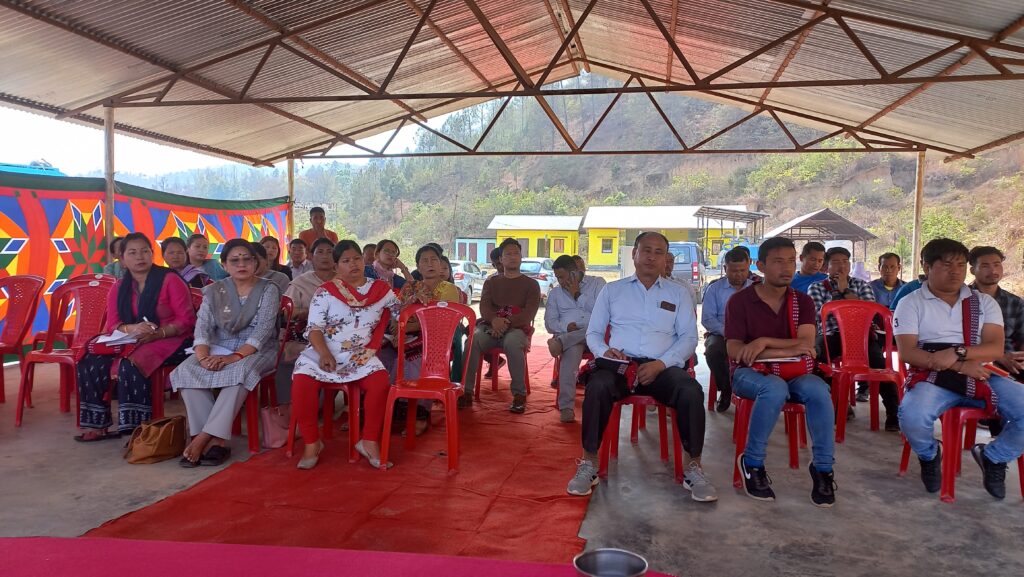
Training Sessions
Besides the resource persons from NIRDPR, SIRD, Manipur and State SBM-G, Shri. Ng. Roben Singh, IAS, Joint Secretary (RD & PR), Government of Manipur and Shri Pratha Das, Scientist (CSIR CMERI), Kolkata handled sessions. , Shri. Ng. Roben Singh emphasised that solid waste management (SWM) is a crucial aspect of maintaining a clean and healthy environment. “Effective management of solid waste requires the involvement of various stakeholders, including the community, non-governmental organisations (NGOs), self-help groups (SHGs), and volunteers. While there are provisions in place for solid waste management, there is a need to incorporate and include SHGs, NGOs, and volunteers at the Gram Panchayat level for effective SWM,” he said, and promised support from the Department to GPs that come forward to set up, operate and maintain their waste management units.
Mr. Pratha Das, Scientist (CSIR CMERI), Kolkata took a session on Effective Management and Demonstration of Waste Plastics Pyrolysis Plant, Biomass Briquetting Plant & Waste Composting Plant. During field visit, he explained the facilities for solid waste management available at the GP level.
Field Visits
The participants were taken to Solid Liquid Waste Management Centre at Keirao Langdum constructed under CGF of Shyama Prasad Mukherjee Rurban Mission (SPMRM) with the help of CCDU, PHED, Lamphel pat, Imphal and PHED Imphal East District, Manipur.
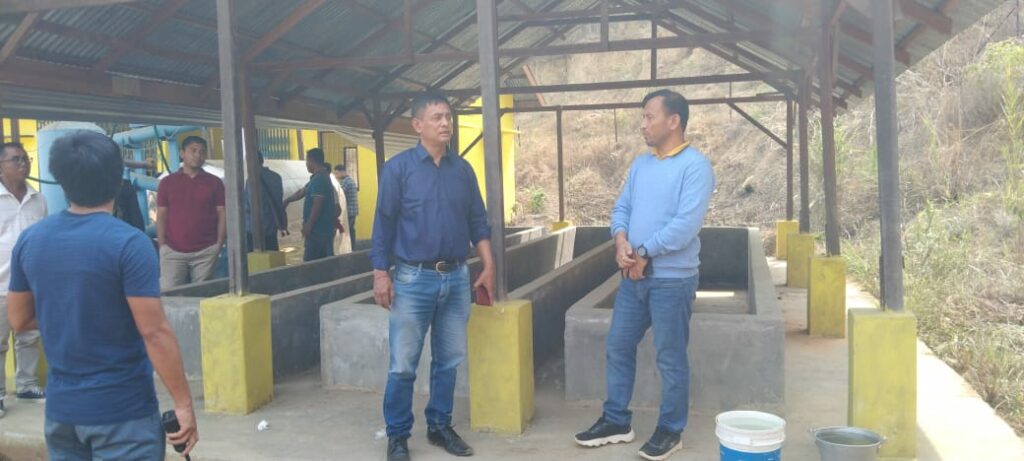
Action Plan
In the last session of the training programme, each team prepared an action plan of SLWM for GP level and presented it before the experts. Based on the points that emerged, the trainers’ team developed a vision statement for solid waste management in Manipur, which is presented below.
ODF Plus Village – Action Plan 2023- 24
Vision for Solid Waste Management: By 2025, reduce the landfill requirement by 80 per cent. The residual waste going to landfill may be hardly 20 per cent, thus significantly reducing the need for new land allocation for dumpsites/landfills.
Mission: (A) By March 2024,improve the waste collection efficiency to reach over 90 per cent, processing and treatment efficiency by at least 75 per cent and reduce the residual waste reaching landfill sites by nearly 50 per cent. (B) By March 2025, improve the collection efficiency by 100 per cent, and processing and treatment efficiency by 80 per cent, and therefore, the amount of residual waste going to the landfill site should not be more than 20 per cent.
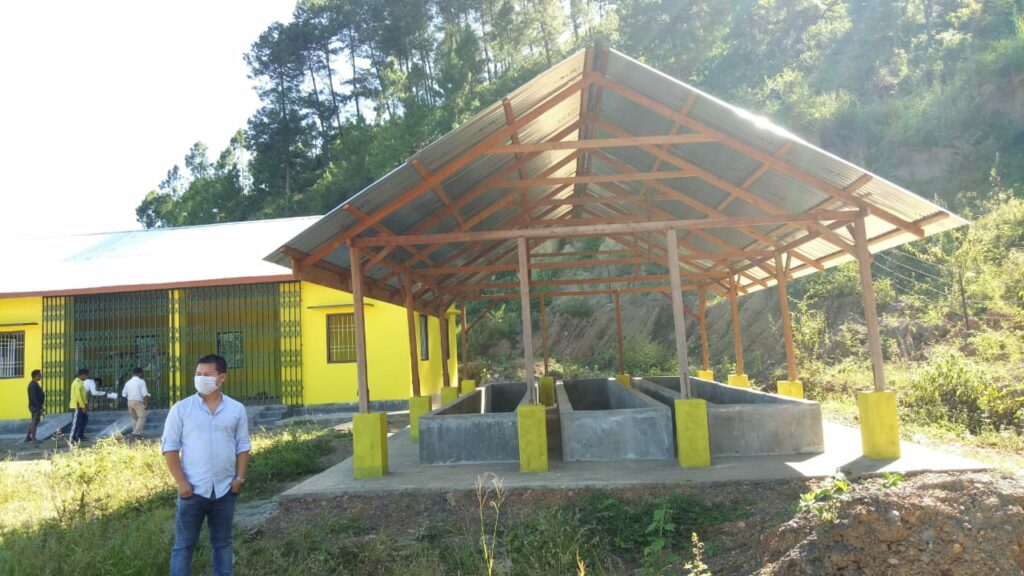
Action Plan 2023-24
- In addition to the existing three GPs which can be called Block Plastic Waste Management (PWM Unit), 12 more PWM Units should be set up in 12 Blocks identified at strategic locations.
- There will be pre-designed facilities, collection and processing arrangements. Thus, the facilities in the existing three GPs will not be replicated in other PWM Units. The infrastructure set up such as shredder, pyrolysis, etc., is not required in other places. Let us minimise the machineries, and provide the other facilities required for waste processing, and convenience.
Solid Waste Management – Village Action Plan 2023-24
- Manipur will follow a ‘cluster approach in solid waste management’. In addition to the existing three Block-level Plastic Waste Management Units, solid waste management units will be established in 12 other Blocks, which will serve the purpose of about 161 GPs in the State. Each PWM will be called the Mother village, and it will serve about 10 to 12 GPs which will be called Service villages under their respective mother GP.
- Every Block may be considered a cluster. Thus, GPs in respective blocks will be tied to a PWM Unit, where they have to send their plastic wastes, i.e. all the dry waste – not just plastic but bottles, etc., too. Processing takes place at PWM Unit. Processing simply means, segregating plastics, bottles, cardboards, milk/oil covers, tetra packs, etc., and keeping them in separate cells/cages. They need to be kept as separate lots so that it is easy for the recyclers to value them, and bid for a price. There should be no shredding of plastics or pyrolysis, etc. Such processes involve heavy operations and maintenance, and skilled manpower, which the GPs cannot bear. This is an unnecessary expenditure even at the Block level. It is good to maintain the minimal infrastructure at GPs/Blocks.
- As a strategy to tide over the problem of households giving mixed-up waste, it is decided that GPs will collect only dry wastes (non-biodegradable waste) from all types of waste generators. Through village-level campaigns, simple home compositing methods including simple burial of biodegradable wastes will be taken up. No wet waste will be collected by GP.
- The idea is that the households will deal with biodegradable wastes; (ii) GPs will make the door-to-door collection of only non-biodegradable wastes, i.e. dry wastes such as plastics, bottles, wrappers, cardboards, etc., through vehicles (iii) the dry waste thus collected by GPs will be sent to Block PWM Unit, where it will be further sorted, and sent to recyclers/kabadiwalas or waste dealers in the town. BDOs should collect and keep the contact details of recyclers/agents involved in waste recycling in every district.
- The Panchayat will not deal with wet waste. The plastics, bottles, cardboards, tetra packs, oil cover, milk cover and other dry waste will be sent to the PWM Unit where it will be segregated and bailed for sale to recyclers. There will be empanelled waste dealers identified in every Block. PWM will have a compressing machine/bailing machine, which can help reduce and compress the plastics so that loading in trucks becomes easy. Each truckload takes more quantity and is economical for transport. The recyclers can reduce the number of trips when plastic is turned into a compressed form. Therefore, every PWM Unit may only have a manual compressor/bailing machine. There is no need for any shredder or pyrolysis, etc., which are expensive to operate and maintain.
- Every BDO should identify waste dealers in their districts, and have them empanelled so that every waste dealer quotes his price for various types of plastics. The highest bidder takes the plastics, bottles, etc. Physical verification before quoting a price may be allowed. The sale proceeds may be used for the Operation and Maintenance of PWM Unit. In addition, the Block Panchayat may also have to provide critical gap funds to meet the shortage.
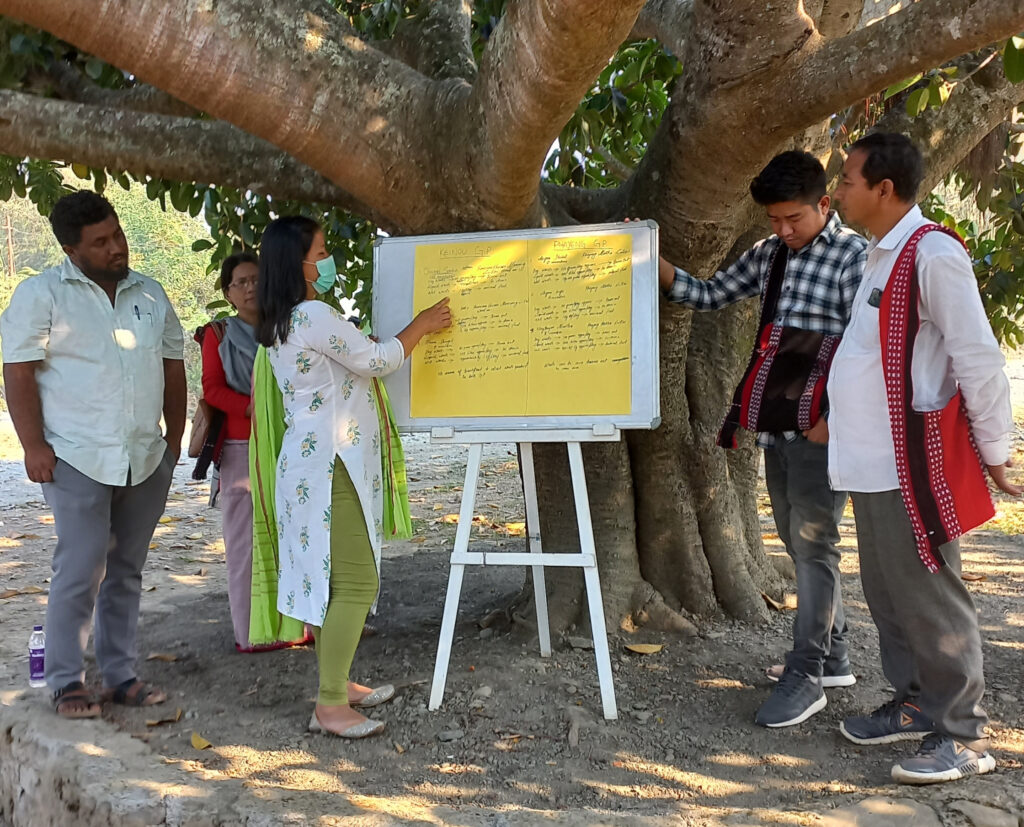
- Facilities at GP level: Regarding facilities, each GP will have a storage place for keeping all the dry waste until (perhaps once in ten days) it is sent to PWM Unit. GPs wanting to take up composting kitchen waste can be trained in doing ‘windrow composting’ which is easy. This may require a shed, and there will be only a shed with a few storehouses (like cells or cages) at the GP level. The campus will be live-fenced/fenced. GPs depending on the area to be covered will have one or two waste collection vehicles (Battery-operated vehicles like autorickshaws), with two sanitation workers trained in waste management. The GP waste management place will have washing and urinal facilities. In the cluster approach, the place required at the GP level as a dumpsite is mostly not required or a very small space may be enough.
- Facilities at Block level: The PWM Unit will have a big segregation shed with a bailer/ manual compressor machine. There will be at least 10 cells/cages and each cell will be used for storing a particular type of dry waste – be it plastics, bottles, tetra packs, etc. Sanitation workers will be recruited every week or once in 10 days, depending on the amount of dry waste estimated to arrive from GPs. However, the PWM will be daily operational because the sanitation workers will segregate mixed dry wastes brought and deposited by all the GPs from the block. They will be put in respective cells for sale once a cell is full.
- This process will reduce the need for waste to go to dumpsites. The amount of waste (residual/inert waste) sent to the dumpsite may become less than 20 per cent. Such GPs/Blocks may be honoured with ‘Zero Waste GPs’ awards. Thus, it is possible to reduce the need to find new locations as dumpsites, given the current land prices and the possible land, water and air pollution caused by indiscriminate disposal of waste.
- First of all, collection efficiency must be improved. For this, every GP should be provided with appropriate waste collection vehicles and trained sanitation workers. Their task should be to ensure 100 per cent collection efficiency.
- There should be a site identified in every Block to locate PWM Unit, and a landfill site to dump the residual/inert waste. Design for PWM Unit and methods to select landfill site will be provided. The task of the PWM Unit should be to segregate all dry wastes into different categories and store them in respective cells in the segregation shed until they are sold to recyclers. Thus, the processing efficiency of PWM unit should be not less than 80 per cent. They may send hardly 20 per cent of inert waste to landfill. Thus, the PWM Unit, if properly managed and monitored, can reduce the need for landfill sites to be expanded year after year. Rather, the reverse, i.e. recovering existing landfill sites and bringing them back to use through separate bio-mining projects, is possible. Bio-mining projects recover the existing dump sites and bring them back to use. Such a project is going on at Thiruchirapalli in Tamil Nadu.
- To deal with diapers, sanitary pads, etc., in GPs/Blocks, the department may talk to the Sub-health Centres, and PHCs to set up incinerators for disposing of biomedical wastes. Biomedical waste should not be mixed up with regular waste collected. Therefore, using NRHM or Health Fund of the 15th FC funds every sub-health centre/PHC should set up Incinerators to incinerate medical waste within the campus of the health centre. The GP can request such health centres to allow them to put sanitary pads/diapers also along with biomedical wastes. Sanitary pads should be treated like a biomedical waste.
- It is possible to make paver blocks, etc., using construction/demolition waste. The State SRLM may be used for such livelihoods using construction waste.
- E-waste may not be generated at the GP level. However, the Manipur State Pollution Control Board (SPCB)/EPR agencies may be contacted to deal with e-waste. Similarly, points related to air quality, mining activity, noise pollution, etc., may be discussed with State Pollution Control Board and prod the relevant authorities to take action.
- Regarding greywater management, a survey is being conducted using a mobile app called COBO Collect/ODK, etc. Once the data is in place, this may be taken up. However, the effort should be to recycle wastewater for improving the green cover in the State. This is possible when taken up with the State Forest Department and MGNREGS. The Government of Telangana has demonstrated admirable results in improving green cover in every GP by planting saplings received from Forest Department. It has used MGNREGS workers in planting, watering and raising saplings for up to three years, and then it becomes sustainable. The choice of tree saplings and common lands to plant them is done in consultation with the Department of Forests and Local GPs. This will improve the green cover along with the clean cover SBM-G is providing.
- Monitoring formats, which are simple to use and monitoring, and result-oriented, must be developed. The benchmark to tell about the achievement in solid waste management should be: ensuring 100 per cent collection efficiency, and secondly, what goes into the landfill or dump site should be less than 20 per cent. Eighty per cent is processed and sent for recycling. This is the real mark of efficiency in solid waste management. The landfill site requirement for Manipur should be gradually coming down year after year. By 2025, the amount of waste going to the landfill should be less than 20 per cent of the total waste collected. This is the hallmark of efficiency. Land can be put to several other useful purposes, and not be used as landfill sites.
The training programme was coordinated by Dr. R. Ramesh, Associate Professor & Head, Centre for Rural Infrastructure, NIRDPR, Hyderabad and Shri O. Lokendro Singh, Joint Director (Training), SIRD, Manipur.
CIAT&SJ, CEDFI Conduct ToT on Entrepreneurship & Sustainable Livelihood Models for Rural Communities
The Centre for Entrepreneurship Development and Financial Inclusion (CEDFI) in collaboration with the Centre for Innovations and Appropriate Technology for Skills and Jobs (CIAT &SJ) at the National Institute of Rural Development and Panchayati Raj, Hyderabad, organised a five-day training program on Entrepreneurship and Sustainable Livelihood Models for Rural Communities during 13th – 17th March 2023.
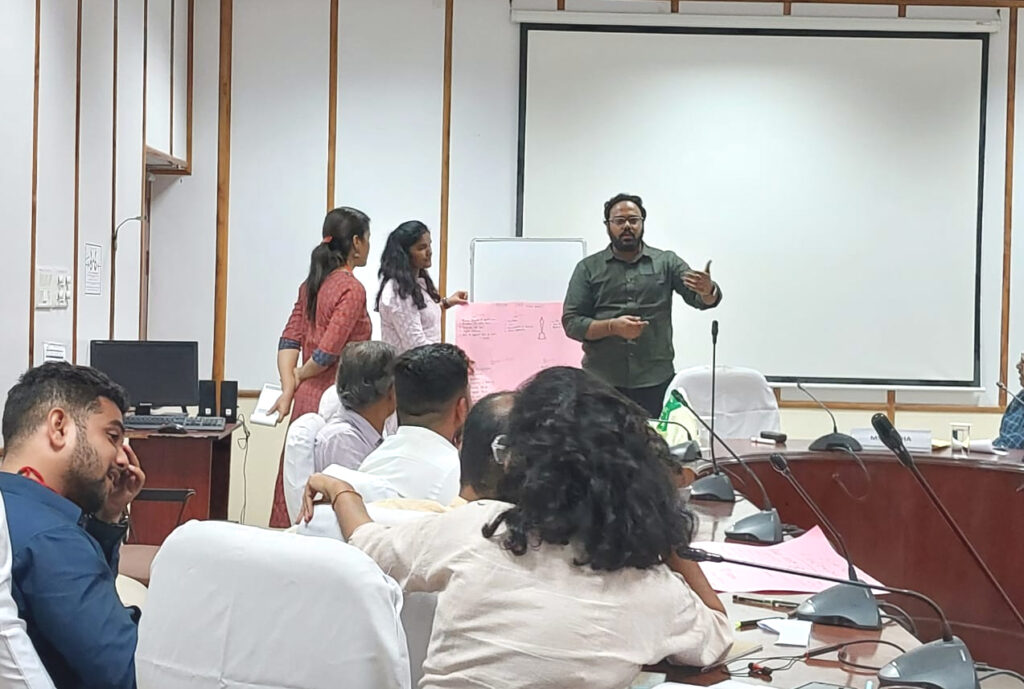
The ToT covered a wide range of topics related to rural entrepreneurship, including inclusive and sustainable rural enterprise development, rural technology parks, gender mainstreaming, mushroom cultivation, rural tourism, value chain analysis, collectives and aggregation models, and psychosocial development. The ToT provided an excellent platform for learning and gaining insights into the nuances of rural entrepreneurship. Brief session-wise discussion points and key learning are as follows:
Inclusive and Sustainable Rural Enterprise Development: The session explored the opportunities, challenges, and possibilities of inclusive and sustainable rural enterprise development. The key takeaways from the session were the need for a multi-stakeholder approach to rural development, the importance of designing programmes that are inclusive of all groups, and the potential of rural entrepreneurship to create sustainable livelihoods for rural communities.
Visit to Rural Technology Park (RTP): RTP showcased the various technologies and innovations that can be leveraged for rural development and entrepreneurship. It provided an opportunity to learn about the various technologies and innovations that can be used to promote rural entrepreneurship. The key takeaways from the visit were the importance of appropriate technology for rural communities, the potential for technology to enhance the efficiency of rural enterprises, and the need for continuous innovation to keep up with changing needs.
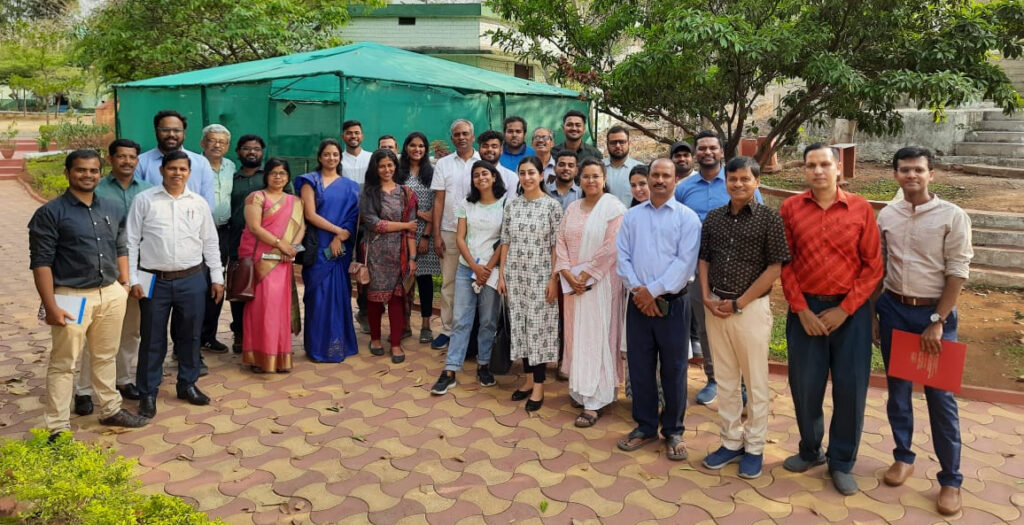
Mainstreaming Gender in Rural Entrepreneurship and Livelihood: The session highlighted the need for gender-sensitive policies, programmes, and initiatives. The key takeaways were the need for gender-sensitive programmes, the importance of addressing gender-based barriers to entrepreneurship, and the potential of women entrepreneurs to contribute to rural development.
Field Visit to AgHub at PJTSAU, Hyderabad, Telangana: The field visit to AgHub on the PJTSAU campus provided an opportunity to learn about the various technologies and innovations used in agriculture allied sectors. The key takeaways were the potential of agriculture and allied sectors to create sustainable livelihoods, the importance of technology in enhancing the efficiency of agriculture and allied sectors, and the need for continuous innovation in agriculture and allied sectors.
Technology, Innovation, and Progress: An Opportunity for Rural Entrepreneurs: The session discussed the role of technology, innovation, and progress in promoting rural entrepreneurship. The key takeaways were the potential of technology to enhance the efficiency of rural enterprises, the importance of continuous innovation in keeping up with changing needs, and the need to design programmes that cater to the specific needs of rural communities.
Potentials of Mushroom Cultivation in Promoting Entrepreneurship: The session explored the potential of mushroom cultivation in promoting entrepreneurship and livelihood and nutrition security. The key takeaways were the potential of mushroom cultivation to create sustainable livelihoods, the importance of nutrition security in rural communities, and the need for continuous innovation in mushroom cultivation. It also emphasised the need for skill development, technology transfer, and market linkages.
Promoting Entrepreneurship through Rural Tourism and Homestay: This session discussed various models, strategies, and best practices for promoting rural tourism. The key takeaways were the potential of rural tourism and homestay to create sustainable livelihoods, the importance of providing necessary support services to rural entrepreneurs, and the need to design programmes that cater to the specific needs of rural communities.
Value Chain Analysis: Opportunities and Challenges: The session explored the concept of value chain analysis and its potential in promoting entrepreneurship in rural areas. The key takeaways were the importance of value chain analysis in identifying opportunities for rural entrepreneurs, the need for appropriate support services to enhance the efficiency of value chains, and the potential of value chains to create sustainable livelihoods. It highlighted the need for stakeholder engagement, market intelligence, and value addition.
Collectives and Aggregation Models: Case of FPOs: The session discussed the role of collectives and aggregation models, with a specific focus on Farmer Producer Organisations (FPOs). It showcased various models, structures, and functions of FPOs. The trainers explained how FPOs could help small-scale farmers by providing them with collective bargaining power, reducing transaction costs, and improving market access. The session also discussed various success stories of FPOs from different regions. The key lessons include understanding the importance of collective action and collaboration among farmers, learning about the different models of FPOs and how they can be beneficial for small and marginal farmers, and gaining knowledge about the challenges faced by FPOs and how to address those.
Psychosocial Development and Communication Skills: The ToT highlighted the role of psychosocial development in empowering entrepreneurship and promoting sustainable livelihoods. It was an interactive session on psychosocial development and how it can help individuals develop the skills and mindset necessary for entrepreneurship. The session also discussed various techniques for promoting psychosocial development. It emphasised the need for personal and interpersonal skills, emotional intelligence, and stress management.
Formulation of Business Plan: This session focused on the importance of business planning in entrepreneurship. The trainers explained the components of a business plan, including market analysis, financial projections, and risk assessment. The session also discussed various tools and techniques for formulating a business plan.
Nearly 28 participants from diverse backgrounds, including faculty and directors of RSETI, young professionals/officials of the State Rural Livelihood Mission (SRLM), NGO representatives, CSR representatives, faculty of technical institutes, and fellows of the MGNF programme belonging to 11 States, namely Karnataka, Madhya Pradesh, Telangana, Andhra Pradesh, Odisha, Punjab, Gujarat, West Bengal, Bihar, Chhattisgarh, and Haryana attended.
The ToT was significant in many ways. As an educator, researcher, and trainer, I gained a deeper understanding of the various aspects of entrepreneurship and livelihood promotion, as well as the complexities of rural entrepreneurship. From understanding the importance of inclusive and sustainable rural enterprise development to learning about the potential of mushroom cultivation and rural tourism in promoting entrepreneurship, the ToT covered a wide range of topics. I learned about various models, strategies, and best practices for promoting rural entrepreneurship and livelihood. The ToT provided me with a valuable opportunity to network with fellow professionals, share experiences, and learn from each other. Overall, the ToT was a transformative learning experience that enriched my knowledge, skills, and perspectives.
Ms. Apoorva Patel, Gujarat National Law University
(Views expressed are personal.)
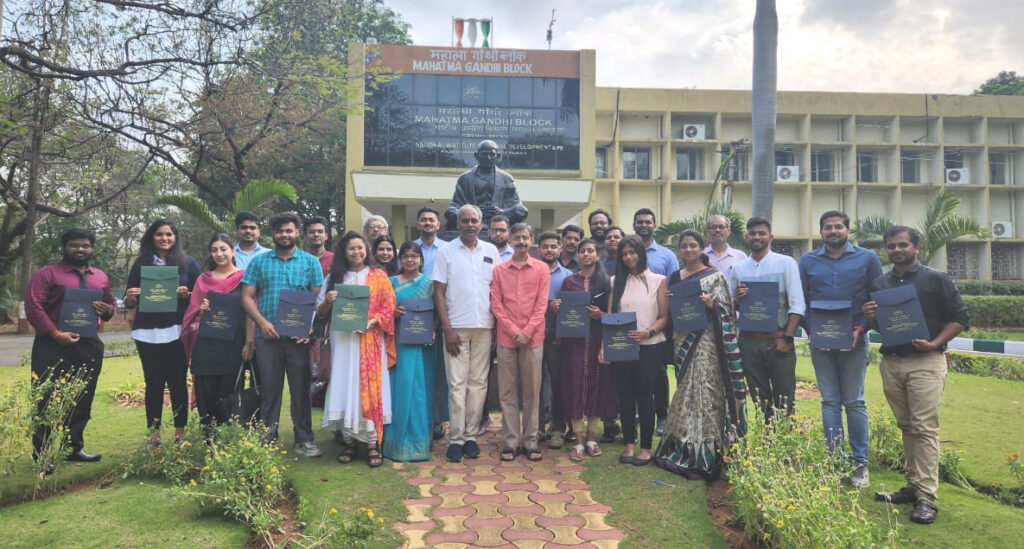
Pre and post-training quizzes were undertaken and the participants received certificates upon programme completion Besides providing detailed feedback on the Training Management Portal, they shared their experiences and provided suggestions for improvement in subsequent training programmes. Based on feedback from participants and resource persons, the programme was satisfactory in all respects, and its objectives and goals were realised. Dr. Partha Pratim Sahu (CEDFI) and Dr. Ramesh Sakthivel (CIAT&SJ) NIRDPR coordinated the training programme.
(Note: Ms. Apoorva Patel, a participant of the said programme, prepared this report with inputs from Dr. Partha Pratim Sahu)
MoRD Official Language Division Officials Visit NIRDPR
The officials from the Official Language Division of Ministry of Rural Development, New Delhi visited the National Institute of Rural Development and Panchayati Raj, Hyderabad in connection with the inspection on the progressive use of Hindi. Shri Shashi Bhushan, Deputy Director General and Dr. Jyothis Sathyapalan, Professor and Head, CDC were present during the inspection and apprised the MoRD team of the works of the OL section of the Institute.
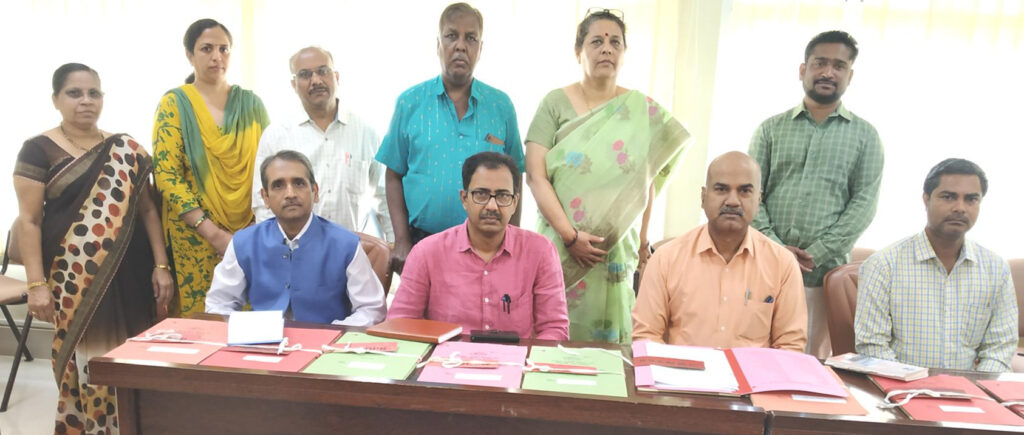
Officials from OL Section, NIRDPR visited NIRDPR-NERC, Guwahati and NIRDPR, Delhi branch for the inspection of progressive use of Hindi. Hindi workshops were also conducted at both centres.
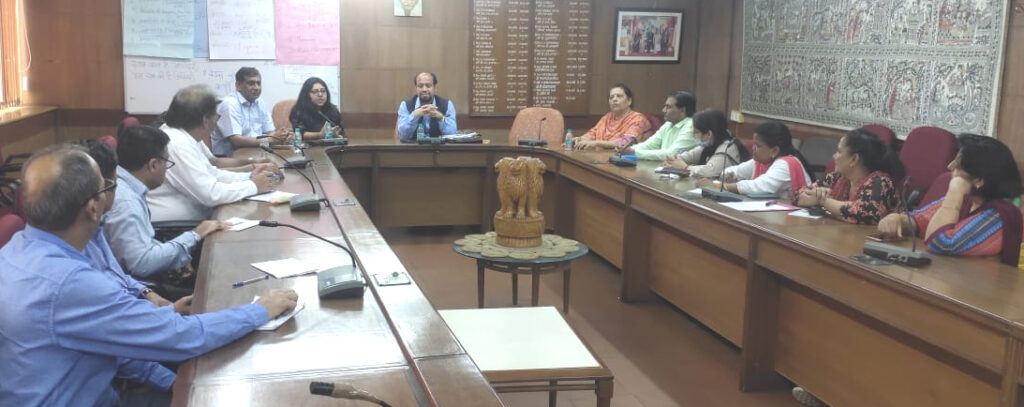
Dr. Ruchira Bhattacharya, Assistant Professor, Shri Chiranji Lal Kataria, Assistant Director, Delhi Centre, Shri Vinod Sandlesh, Joint Director, CTB, officials of NIRDPR OL section and participants attended the workshop at NIRDPR, Delhi branch.

Dr. R. Murugesan, Director, NIRDPR-NERC, Arup Sharma, Administrative Officer, NIRDPR-NERC, Guwahati, OL officials and participants attended the workshop at NIRDPR-NERC, Guwahati
Workshop-cum-Training on Deprived Sections and Reachability of the RD Schemes at SIRD, Meghalaya
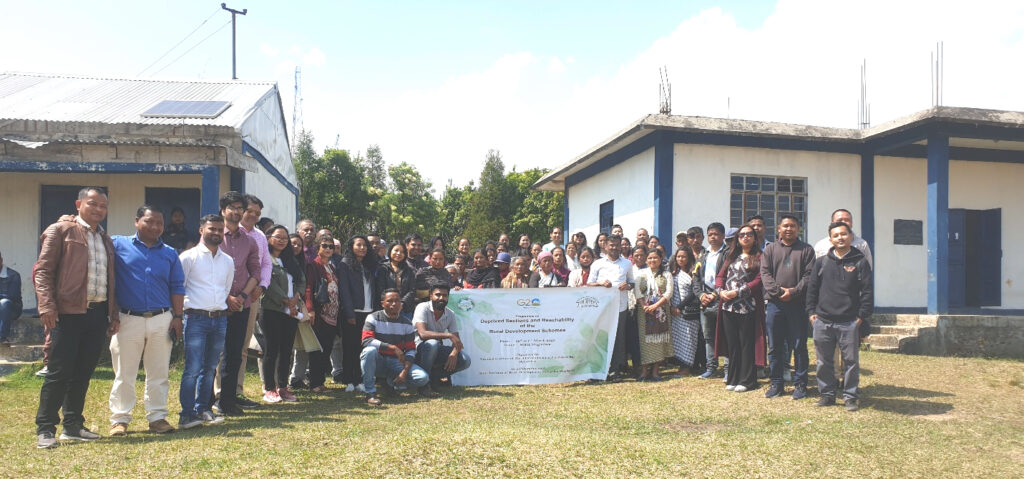
The Centre for Equity & Social Development (CESD), NIRDPR conducted a workshop-cum-training programme on ‘Deprived Sections and Reachability of the Rural Development Schemes’ at SIRD, Shillong, Meghalaya. Dr. S. N. Rao, Associate Professor & Head, CESD, NIRDPR and Smt. Lizelda Dkhar, SIRD, Meghalaya were the Course Directors.
Dr. (Smt.) Anita, P. Jyrwa, Joint Director, SIRD, Shilling, Meghalaya delivered the inaugural address. “Meghalaya is a remote State having hilly areas. Deprivation exists in many forms and remoteness is one of them. Poverty deprives health and education, which are foremost factors of human resource development. Flagship programmes reduce deprivation and helps people to overcome poverty. BOTTOM-20 Approach is an innovative concept of Government of Meghalaya to reach the deprived in remote rural areas,” she said.
Dr. S. N. Rao, Associate Professor & Head, CESD, NIRDPR, in interaction with the participants said that equity is an important factor in rural development. “Equity plays a vital role in realising the global goals. The pandemic has increased the inequalities and many families lost their livelihoods, and the divide between rich and poor has widened during pandemic. It is the RD Schemes like MGNREGA has protected from hunger and provided employment in dire need of the hour. Equity is treating everyone fairly in the society and reaching the developmental benefits to everyone and everywhere. PVTGs, single women-headed families, specially abled people, transgender people, Scheduled castes and Scheduled tribe and senior citizens should be given prominence, as they are more deprived. The RD Schemes must reach the deprived people to bridge the gap in development process,” he added.
MGNREGA
Shri. J. Songthiang, discussing the pioneering role of MGNREGA, said that MGNREGA is a lifeline and empowered the villages in Meghalaya. “Due to VI Schedule, the implementation of MGNREGA in the State is delayed. The State has encountered many challenges in implementation of the MGNREGA. Village Employment Councils (VECs) were created at village level and Area Employment Councils (AECs) were created at cluster level to create employment. These institutions have become not only for execution of works but also became planners, record keepers and vigilance and monitoring units,” he said.
The most important innovative concept in Meghalaya is BOTTOM-20 Strategy. The concept aims to reach the needy and poorest of the poor. BOTTOM – 20 approach is used for the selection of MGNREGA beneficiaries. In 2016-17, the Government of Meghalaya has taken an initiative to develop livelihood activities for bottom 20% of poorest and most vulnerable households every year in convergence with MGNREGA and known as BOTTOM-20 Strategy.
The objectives of the strategy are to create ‘Sustainable Livelihoods’ and ‘supporting infrastructure’ for enabling rural poor to overcome poverty, enhance income generation of poorest households by providing alternative source of Livelihoods and facilitate ‘gradual upward social mobility’ of job seekers – moving them from wage employment seekers to self-employed entrepreneurs. The BOTTOM-20 is helping the needy and poorest of the poor in Meghalaya.

NRLM
Regarding NRLM, Smt. Lydia Malngiang, said that in Meghalaya, there are 60 Cluster Level Federations (CLF), 4482 Village Organisations, 43,829 SHGs, and 4,38,290 SHG members. NRLM has a special focus on priority and inclusion of the poorest of the poor and other vulnerable sections of the community into the SHG fold. Meghalaya SRLM is helping transformation of the SHGs from social capital to economic capital and reaching the poorest of the poor in assistance.
NSAP
Dr. S. N. Rao mentioned that NSAP, a flagship programme of MoRD, is a significant step towards the fulfilment of the Directive Principles of Article 41 of the Constitution, concurring responsibility of the Union and the State Governments. The findings of study conducted by NIRDPR on NSAP in eight States show that it is an important social safety net programme, by helping the people who are suffering financially.
Dr. Ruchira Bhattacharya, Assistant Professor, NIRDPR-Delhi branch said that women are more deprived economically, socially, and economically. “Culturally, the women are deprived at homes, and in the society. Although, women have gender equity, and contributes economically, politically they are weak. In Nagaland, it has taken a 75 years women to become an MLA and Minister. But, slowly the society is changing. At grassroots level, women’s contribution is high. The studies point out that women headed PRIs have shown development considerably. NRLM encourages the women to form SHGs as a social expression. Women’s literacy rate and employment percentage are constantly increasing,” she said, adding that future belongs to women.
DDU-GKY:
Shri. Lambok Dhar, Meghalaya State Coordinator, DDU-GKY said skills play a vital role in employment.
More skills add to the employability of a person. Challenges faced by the DDU-GKY in Meghalaya include reluctant to undergo training and placement outside the State, bad perception/information on skilling programmes, candidates not meeting the required educational qualifications, non-availability of necessary documents for registration and the fear to open bank account and Aadhaar registration, and poor connectivity and non-availability of transport facilities in remote areas.
PMAY-G
Shri. Paul D. Passah, Programme Manager, PMAY-G in interaction with the participants, informed that PMAY-G is the most successful programme in Meghalaya.
Under PMAY-G, the beneficiary will construct the house herself/himself or get it constructed under her/his supervision. Technical supervision and support for construction of houses will be provided by the Block officials. The State has also developed a few house designs to provide technical guidance to the beneficiaries.

A field visit was made to Wahlyngkhat village in rural Meghalaya, where the Participants interacted with the beneficiaries of MGNREGA, NRLM, PMAY-G, NSAP, DDU-GKY and PMGSY. Field observations by the participants are mentioned below.
- Government of Meghalaya has introduced innovative concept of BOTTOM-20 to reach the poorest of the poor. Service delivery is the core aspect of governance to reach the people at bottom/local level.
- Meghalaya is having the traditional governance at local level i.e., Village Headman plays a crucial role in service delivery and reaching the services to the people in development process at village level. The traditional governance/informal customary process plays a vital role in service delivery to the poorest of the poor. The people at village level values the traditional governance and abides the customary process of governance. The trust between traditional governance and the people are core issue in service delivery system in Meghalaya. The State has followed the BOTTOM – 20 to provide the benefits to vulnerable and poorest of the poor.
- During the pandemic, MGNREGA turned a lifeline of rural people in Meghalaya.
- NSAP beneficiaries were happy because they get 10 kg of rice every month. They wanted the assistance of Rs.1,000 to be increased up to Rs. 3,000.
- Since DDU-GKY is not popular, awareness should be created through banners. Although, there are success stories from the village, the beneficiaries are working outside Meghalaya and hence, success is not visible in the State.
- PMAY-G is the most successful schemes and the beneficiaries have thanked the Central and State governments for realising their dream.
- PMGSY is the toughest scheme to implement in Meghalaya due to hilly terrain. A road built under the scheme connecting three villages has improved the transport, livelihoods and helped children access education.
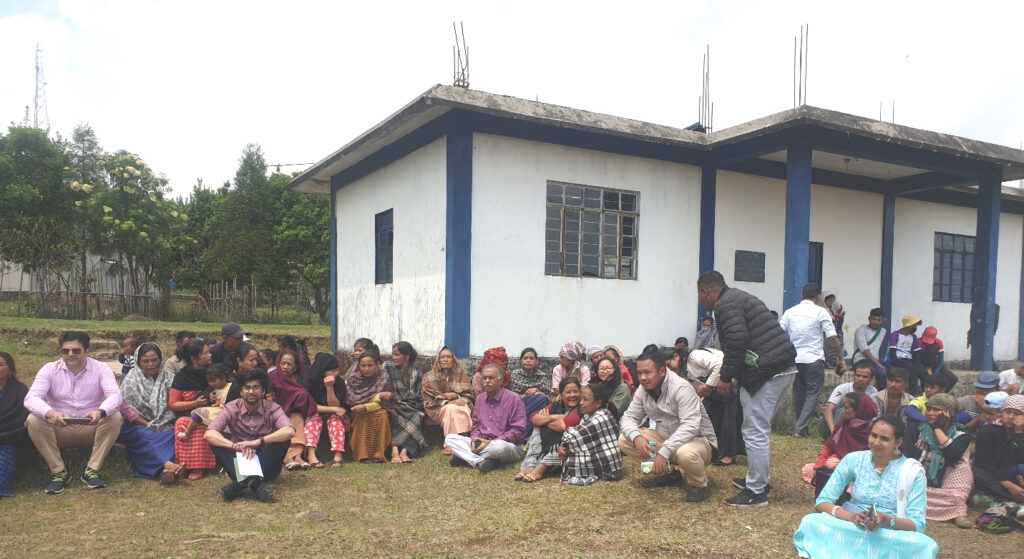
The participants felt that training helped them understand different flagship programmes of MoRD, GoI, and added that the field visit enriched their knowledge and motivated them to reach out the deprived people in their respective States.
World Water Day-2023: CRU-NIRDPR Releases Posters
As part of the World Water Day campaign, the Communication Resource Unit (CRU) of NIRDPR has designed and released a series of posters and social media tiles for the States of Andhra Pradesh, Karnataka, and Telangana. This annual campaign held on 22nd March aims to raise awareness and promote a better understanding of the critical role that water plays in our lives. These materials were developed in three languages – English, Telugu, and Kannada – with the goal of promoting awareness and understanding of water conservation, grey water management and the importance of safe and clean drinking water.
Please find the posters and social media tiles of the campaign below:
